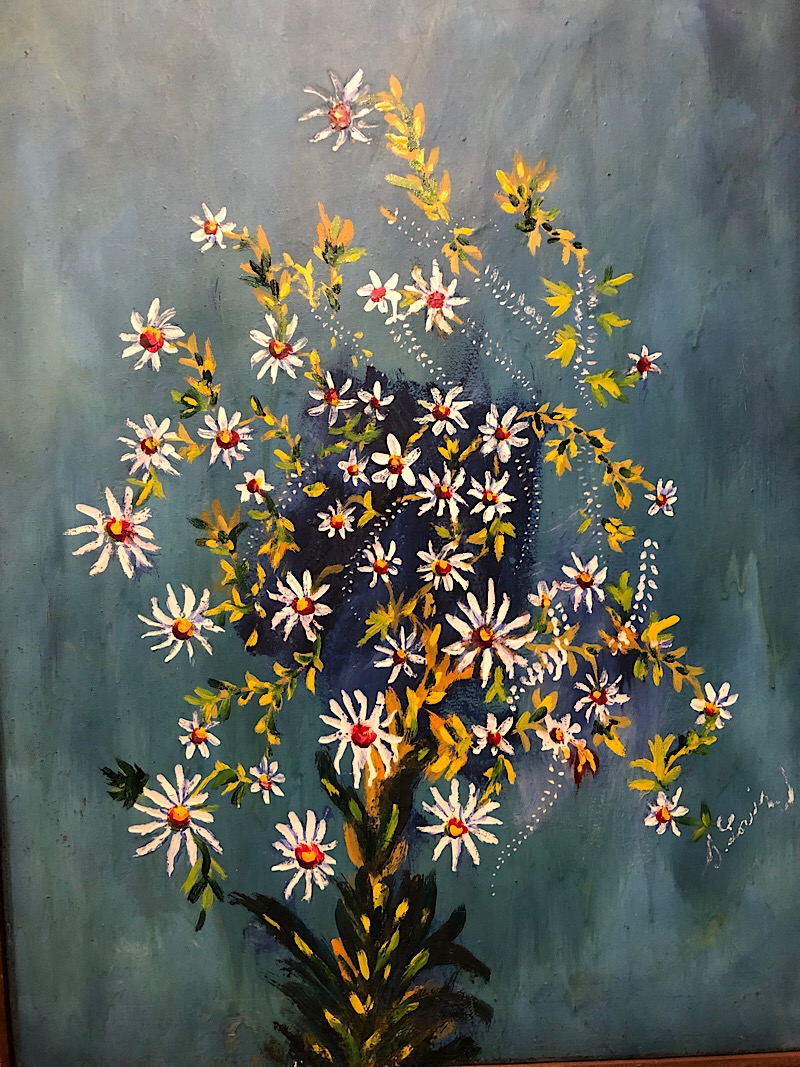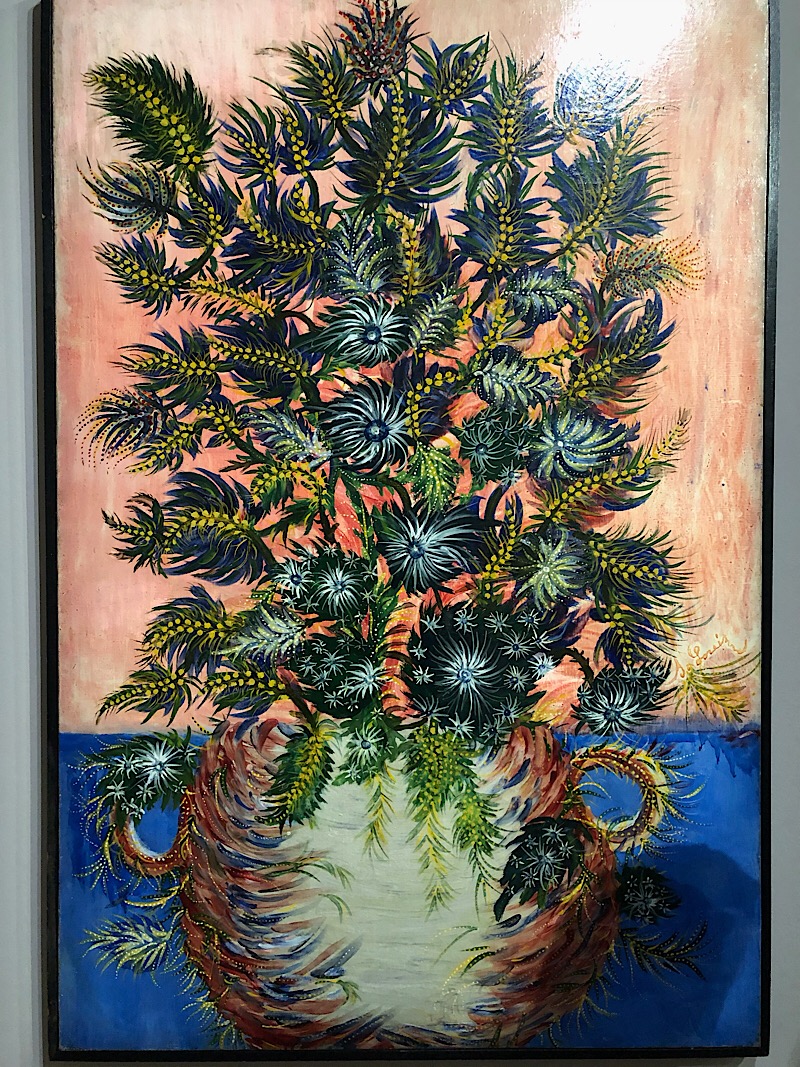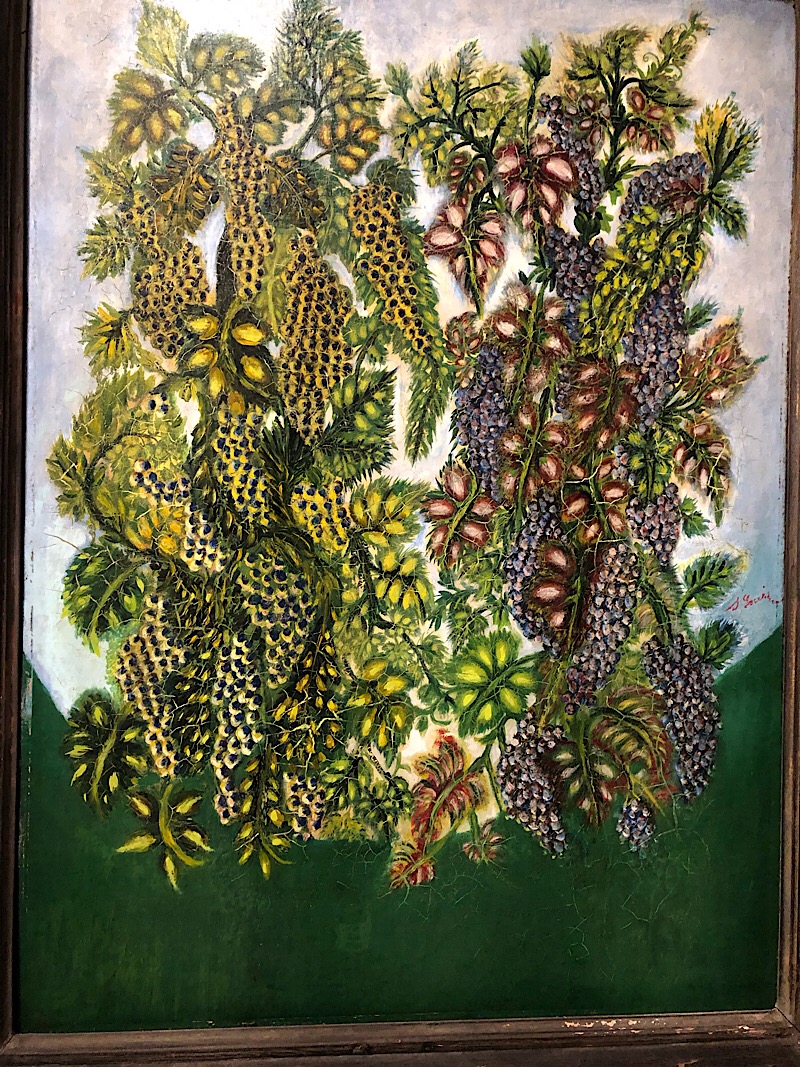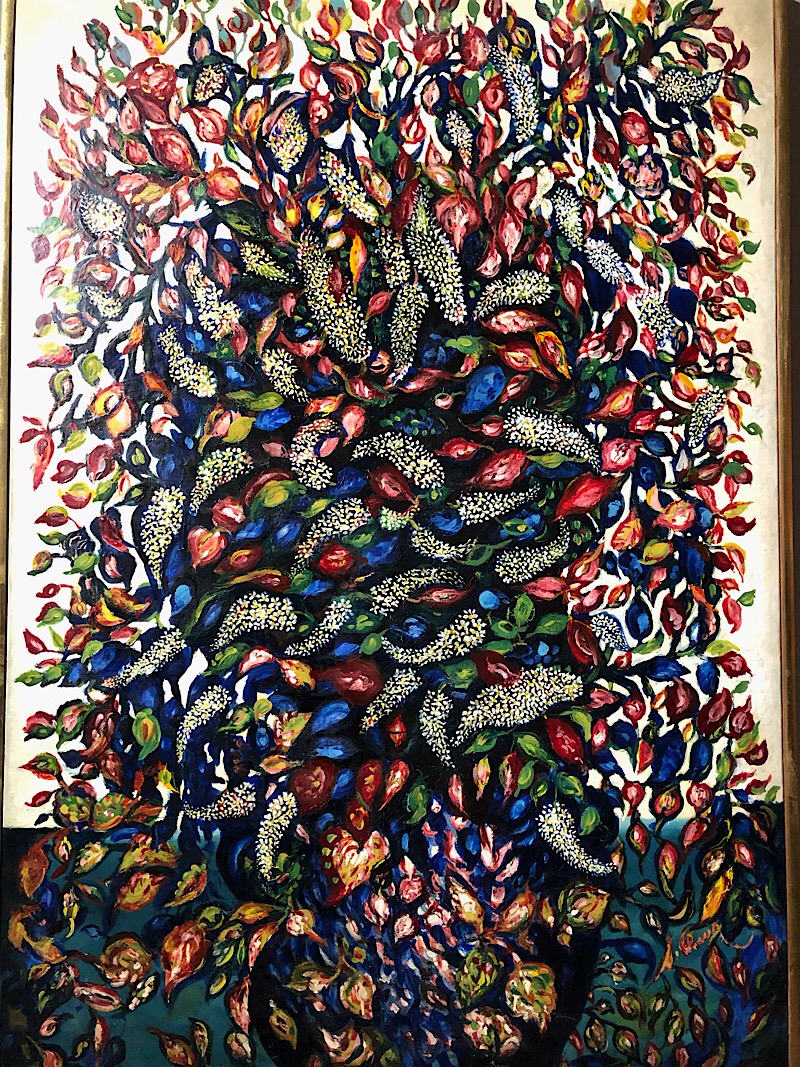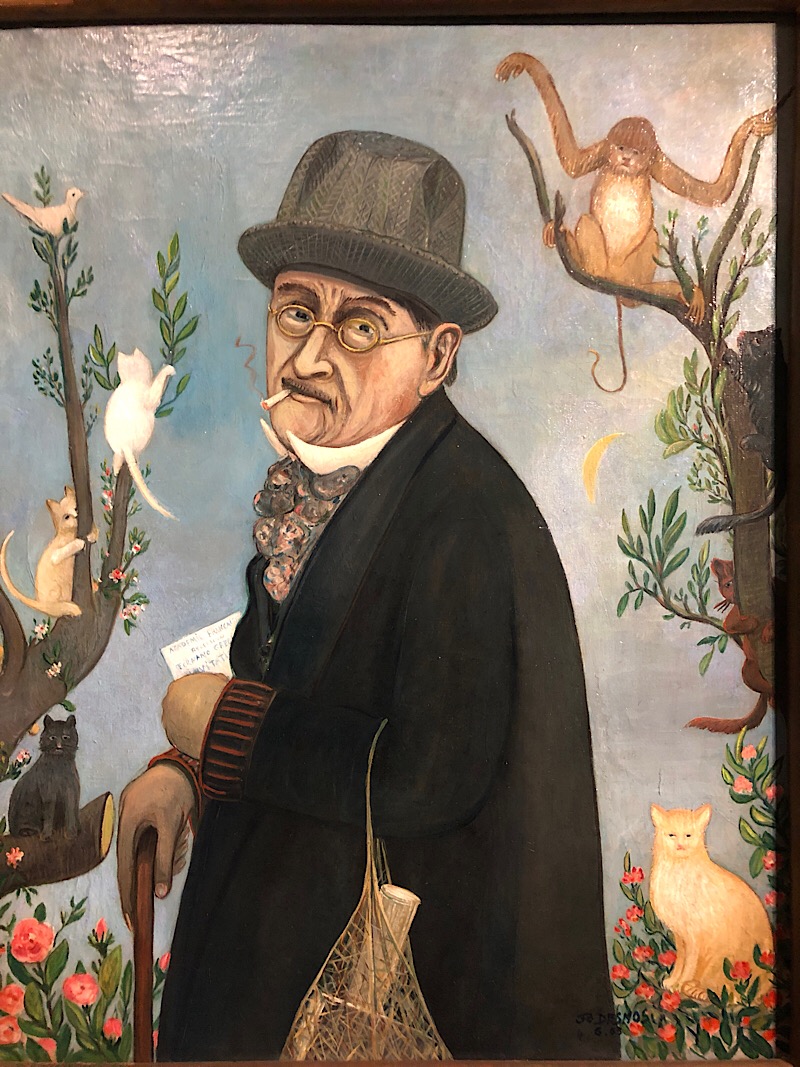Home Page of All Travelogues
Previous: 2018 Third Trip to Guadeloupe
Corsica/Paris Introduction
Introduction
Corsica
Paris
Wrapup
Paris Museum Photos
Previous: 2018 Third Trip to Guadeloupe
We welcome comments. Please send them to Stephen and Dawn
Corsica/Paris Introduction
October 4 - November 1, 2019
Introduction
Corsica
Paris
Wrapup
Paris Museum Photos
(top)
How It Started
Dawn said she was ready for another trip. She said how about France in the fall? I thought maybe a month in Paris. Dawn said what about Corsica? Or visiting Veronique in Bruges or Paradou in Southern France. The Cevennes made famous by Robert Louis Stevenson’s hike with a donkey beckoned Dawn. I had no idea how to plan such a trip so I made reservations to fly to Paris for the Month of October and figured we could get to anywhere from there. That was the middle of July.It looked for a while that we would wander around france seeing things we hadn’t seen and visiting people, maybe a week in each place, but Corsica, a place we had thought about and rejected for a winter trip (too cold and dead), began to bubble up to the top. Vineyards, mountains, hiking, lots of small villages drew us in and soon we decided to do two weeks in Corsica and followed by two weeks in Paris. A really new place and a really old place.
Geography (from Wikipedia)
Corsica was formed about 250 million years ago with the uplift of a granite backbone on the western side. About 50 million years ago sedimentary rock was pressed against this granite, forming the schists of the eastern side. It is the most mountainous[clarification needed] island in the Mediterranean, a "mountain in the sea".It is also the fourth largest island in the Mediterranean, after Sicily, Sardinia and Cyprus.
It is 183 km (114 mi) long at longest, 83 km (52 mi) wide at widest, has 1,000 km (620 mi) of coastline, more than 200 beaches, and is very mountainous, with Monte Cinto as the highest peak at 2,706 m (8,878 ft) and around 120 other summits of more than 2,000 m (6,600 ft). Mountains comprise two-thirds of the island, forming a single chain. Forests make up 20% of the island.
About 3,500 km2 (1,400 sq mi) of the total surface area of 8,680 km2 (3,350 sq mi) is dedicated to nature reserves (Parc naturel régional de Corse), mainly in the interior. Corsica contains the GR20, one of Europe’s most notable hiking trails.
The island is 90 km (56 mi) from Tuscany in Italy and 170 km (110 mi) from the Côte d’Azur in France. It is separated from Sardinia to the south by the Strait of Bonifacio, which is a minimum of 11 km (6.8 mi) wide.
Corsica on Wikipedia

Map
Trip Planning
Stephen;I have looked at hundreds of airbnb sites, deciding fairly early to find places where we would rent rooms in people’s houses. We needed some guidance and we needed to talk to people to learn about Corsica. I picked two, each for four nights and both in small villages, one in the north and one in the south. I folded in some hotels to break up the trip. Tne first BnB reached out to both Dawn and me with its hospitality and warmth. Daniel will be our host. We will arrive on October 4.
Our first town is Corbara is in the Northwest of Corsica and to get to it we will fly to Calvi and rent a car for four days. From there we will return the car and on October take the train to Corte in the middle of the mountains to hike or visit depending on the weather, the next day on the train brings us to Ajaccio, the capital and main city of the island.
We arrive noonish at our hotel After dropping our bags, we will go to the Fesch Museum. It has a bunch of paintings that we want to see. We will find a few other things plus looking for a place for dinner. We leave the next day on October 11, renting a car at the Ajaccio airport around 1 PM so we will have time for something in the morning.
We will drive to our second BnB that afternoon. We have a choice of routes and will seek local advice about which one we should take. In the town of Sari-Solenzara overlooking the sea, we were drawn by the Irish/Corsican couple, the beautiful view and again the food hospitality. Another four nights, walking the beach and hiking in the mountain behind.
On October 15 we will stay in the town of Bonfacio. The chalky cliffs drew us to plan one night there. We are staying, for us, in a little bit of an upscale hotel. We seem to like food and drink. It is right on the water in the Marina with a good view of the Citadel.
Next on the trip is the town of Sartene. It is said to be the "Most Corsican of Corsican towns". It is fairly short drive to the airport and is near the prehistoric sites that we want to see.
We are staying in a nice hotel with a fancy restaurant which might be an option for our last night in Corsica. We will drive from the town to the airport on on October 18, return our car and fly to Orly airport outside of Paris. We will have a couple of public transportation options from there, but should arrive at the apartment around 7 PM.
We are going back to the eleventh in Paris, staying on the ninth floor of an apartment building on the Metro Line 11. We will be there from October 18 until Nov 1.
Two weeks to explore what’s new in the museums, find music, visit with Isabelle and Jean and other friends, sit in brasseries and write the travelogue that will occupy the next two pages. Of course we will visit Notre Dame to walk around its wounded shell and hope for the best.
(top)
Corsica - 2019
Corbara
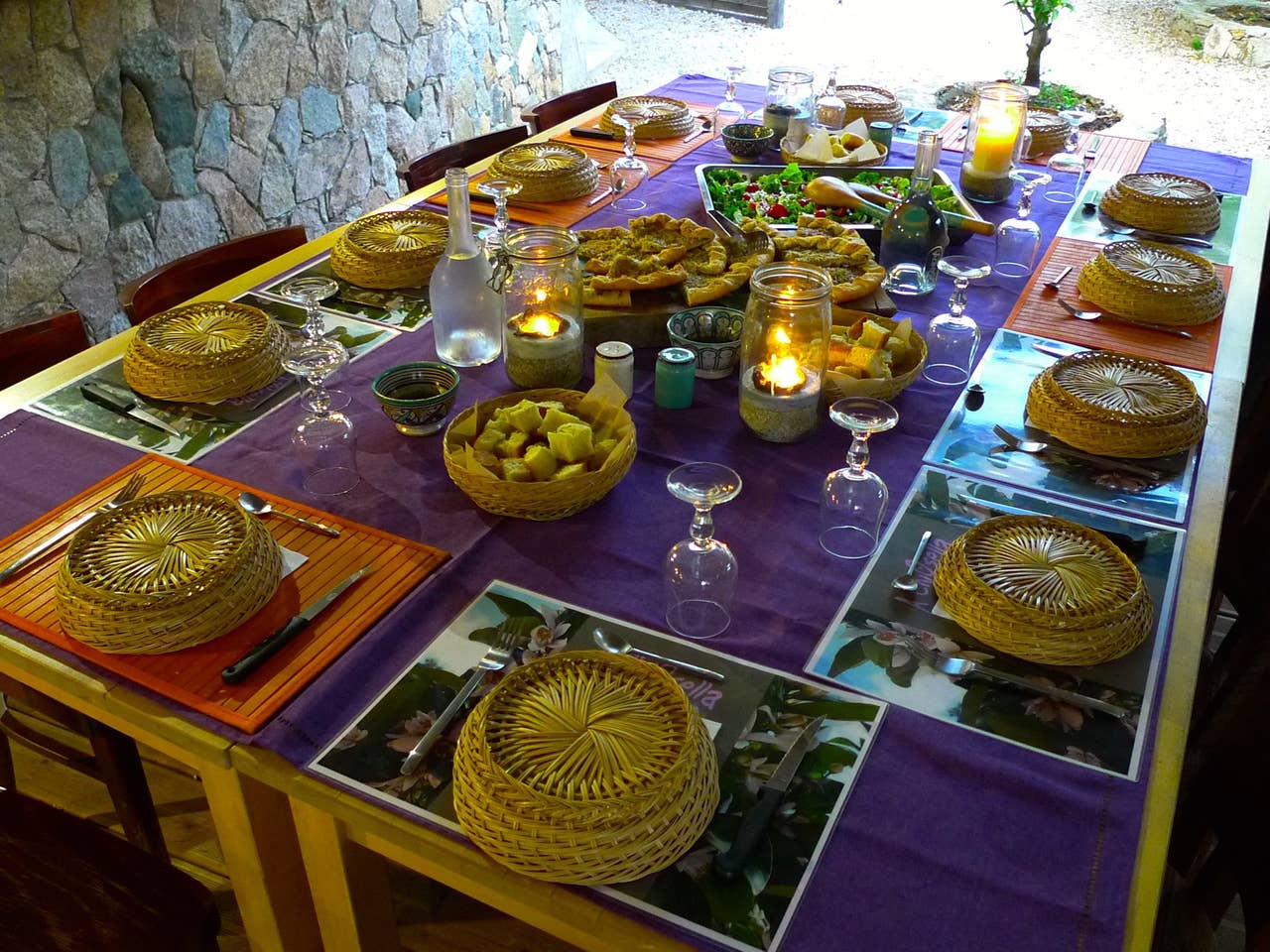
Table d’hote


Stephen:
We have arrived and have begun our exploration of Corsica. It would properly take a lifetime to do it right. We got here by flying overnight to Paris and then taking the direct bus to Orly and then flying to Calvi in Corsica and finally renting a car for the half hour drive to Daniel’s place, called “A Chiosella”. It is a place nestled precariously on many levels among olive and fruit trees on a hill overlooking the town of Corbara. Looking like it has been there forever, it was all terraced and built after 2000. I have a theory that the soul of the architecture of old Europe is carried in the bones of the contractors who build like their fathers before them and their father before them and so on. This doesn’t happen everywhere or all the time, but it happens enough.

I carry two concepts around the meaning of the word “here”. One, where the word is followed by “and now”, where it refers the the physical part of the present moment in Buddhist thought. The other meaning distinguishes where I am now versus the other places that I might have been in the past or will be in the future. When one meditates, one tries to stay in the present time, but when I travel to Europe I feel that the place has a very strong past also. A Chiosella is full of little places to gather. As I sit I recall that civil is the root of civilization and is the root of just surviving. In a group, one must be civil to survive. The history of the place is about growing food, worshipping and a glass of wine. The basics of life make themselves felt very strongly to me as I sit here.

We have been traveling for twenty-five years now. Normally we rent apartments, but because we have never been to Corsica before we decided to get rooms in Airbnbs instead. For us Daniel’s place was perfect.
To simplify our first night, we made arrangements for table d’hôte, where we would eat with our hosts. It can be practically anything, but it turned out to be dinner for ten of the guests who were staying there. Five couples, from Quebec, Switzerland, France, England and of course us from the United States, a dish of white eggplant and one of purple, a dish I don’t remember, a huge salad, a cheese course, tiramisu for dessert followed by a round of digestifs. Took about two and a half hours. In between Daniel played a little guitar and sang folk songs from the various countries of the guests. We were the first to leave, begging off with “jet lag”.
Dawn:
Our table d’hôte dinner the first night was the epitome of why we travel. As Stephen mentioned, there were couples of different nationalities and generations. One of the Swiss couples had an adorable eight-month old baby whom we met at breakfast the next day. The primary language around the table was French, with some English thrown in. Daniel was great at introducing everyone and making us all feel at ease. Daniel’s mother is an essential, energetic part of the operation as well. She and Ines, another guest, discussed various methods of making jams and confits. All the veggies and many of the fruits were grown right there in their garden.

Our room was fine, and I was able to find a good spot for my yoga mat the first morning. Daniel offered to make eggs every morning and enjoyed learning the American expression “over easy.” A couple who shared a common living room with us were an English woman and man from Gascony. As they left, they expressed a fervent wish for a change of administration in Washington in the next election. Yes, the world is waiting and hoping, as we are.
The next day was unstructured. We followed a sign for a restaurant/photo galerie and found the studio of Antoine Perigot, (www.antoine-perigot.com). He was just finishing up his lunch service and asked us to call back after four if we wanted to come to dinner. We said we would. The photographs were mostly in his book, Opera Umana, and were landscapes, all of which had human works in them.
Stephen:
We found a hiking sign for a neighboring town which is where we were also thinking of having dinner. This trip is different for us in that we are staying in rooms rather than apartments, so we have to find restaurants rather than supermarkets to have our meals. This is going to be a challenge in that the island is coming to the end of its tourist season. We decided to walk a little on the path and after immediately taking a wrong turn we recovered and ended up walking over to the town, Pigna. It was mid afternoon when we got there and things were mostly closed, so we called Antoine and left him a message that we were coming to dinner around eight and returned to A Chiosella for a quick nap before walking down to the town for dinner.
When we walked in a little late, there was a group already seated. We were the second and final table. I think he was glad to see us, because the country code 1 was unfamiliar to him and he thought it was some kind of spam. We ordered drinks and he brought over the large book of his work for us to browse through as we waiting. The soup de poison, fish soup was good and I had a salad that was not as good. The rhythm of the meal was different, hard to explain, but like eating at the house of a deranged uncle. He would talk to us and then talk to the other table. The tiramisu was really good. All in all, a couple of hours well spent.
Point Spano


Our little beach for swimming, stretching and meditating and a rock with a view.
Dawn:
Sunday was a gorgeous day. We threw our bathing suits in the backpacks “just in case,” and went off for a hike on the rugged Punta di Spano. It turned out to be such a warm day that we changed into our bathing suits behind some rock formations and truly enjoyed a couple of swims in the Ligurean part of the Mediterranean Sea...in October. Although the following day was cloudy, rainy and downright cold, we learned that most of October is usually warm enough to swim.

Stephen:
The town of Algajola was our favorite beach town and the Chariot was our favorite bar/restaurant. We stopped here twice, once for a drink and then back for dinner when we couldn't find parking in île Rousse because they were having some kind of event. Dinner was a theatrical event, not because there was anything staged, but because of the natural flow of the evening. The strings of overhead lights gained in strength as the sun went down. The place filled slowly as customers entered, each in their own way. Some were tourists, like ourselves, slightly confused as to the rules and being rescued by the accomodating and professional servers. Others were regulars and were greeted by the owner with the customary two kisses. On the edge sat two women who were professional beauties and they knew it. They were accompanied by their boyfriends and the owner spent some time with them as they eased from a couple of rounds of drinks to dinner.
It is hard to describe French servers. They are very efficient, getting you the drinks and food that you want without an extra word. During this evening they seemed as choreographed presences, floating from table to table. The restaurant took over the whole town plaza and it was the only one. Normally there would be at least two, competing with each other in a silent way.
The addition of the palm tree in the square was the only hint that we were not in a village in the south of France.


View from a tabac over île Rousse and then a view from its front into the interior. The little dots over the red roof are actually a small village.

(top)
Changeover Day
Stephen:
We are moving on today,leaving Daniel’s wonderful place. drove the car to the airport and returned it. We called a taxi from the car rental place and now are sitting at L’Amphi at the marina in Calvi, where we have finished lunch. Dawn has returned from buying a new hat.

Now she guards the luggage while I take a little stroll up to the citadel take a couple of photos of the bay of Calvi.



Train Map

Dawn:
The train ride to get there was spectacular, with a combination of mountain and coastal scenery. There is something about boarding a little two-car, narrow-gauge train that is charming and old world. Moreover, the train goes through tiny mountain villages with Italianate ids that seem to be lifted right out of a storybook.
Corte
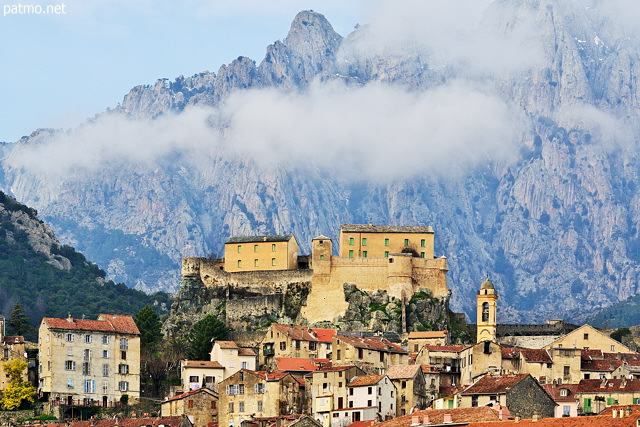
Dawn:
Corte is a mountain town AND a college town. It is a bustling, energetic small city with lots of old buildings and lots of young people. There are also new buildings constructed to house the students. Founded in the 1980's, the university has a large Corsican student body, but it is also part of the Erasmus program, an international student exchange program. I had a little fantasy that maybe my oldest granddaughter, who is now looking at colleges, might want to come here!
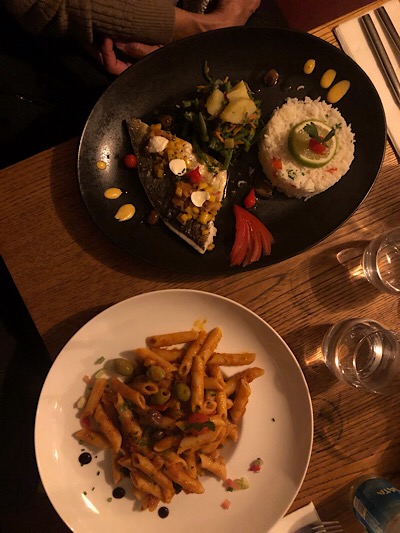
The food at the trattoria was good enough that we went back the second night. Took the same corner table in the back where we both could sit on a padded bench. My pasta is served in a dish that is a combination of a bowl and a plate, somther is more pasta thqn it looks. Dawn had a good fish, dorade.
Hotel U Passu Tempu
A surprising place. The room was small, the walk from the train was a little long. It was quiet and close to the restaurants and the beginning of the hike.Our Hike


Start of the hike on the hotel balconey and looking out into the valley


Dawn on the trail and then Stephen


Dawn cooling her feet on the way back in a side stream
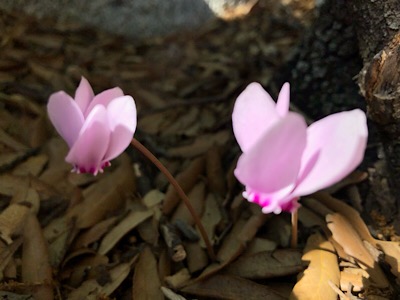

Flowers on the trail - Almost home. Our hotel is just on the other side of the citadel.
Dawn:
We took the Tavignano hike, walking right out of our odd, little hotel room and up to the start of the hike. It was a gorgeous trail. Hopefully our photos will give you an idea of our experience. We met families, students, tourists of all ages, a pair of German women with whom we chatted a bit, but the trail never felt crowded. We didn’t get quite as far as we had initially hoped, but it turned out to be about five hours round-trip which was the right amount for our bodies at this point. We had a nice snack stop of smelly, Corsican brebis (sheep cheese), pain grillé, clementines, and chocolate. On the way down we stopped at a little pool fed by a small waterfall and soaked our feet in very cold water. It felt great.
Train Ride Part 2 - To Ajaccio

Walking to the train station the next morning, we went a different way, through the university, but it was still longer than Alain said it would be. It was certainly quieter. The suspension bridge was a challenge for Dawn as it had a lot of movement in it as we crossed. The train came on time, we found seats and proceeded down the high central valley of the island, bent a little west and descended to the capital city of Ajaccio.
Ajaccio
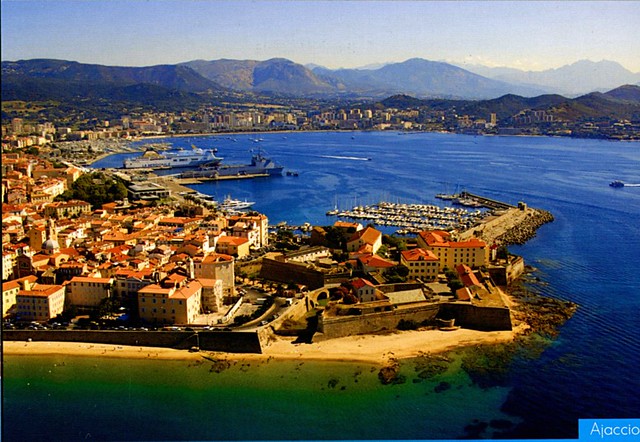
The Citadel and old town of Ajaccio
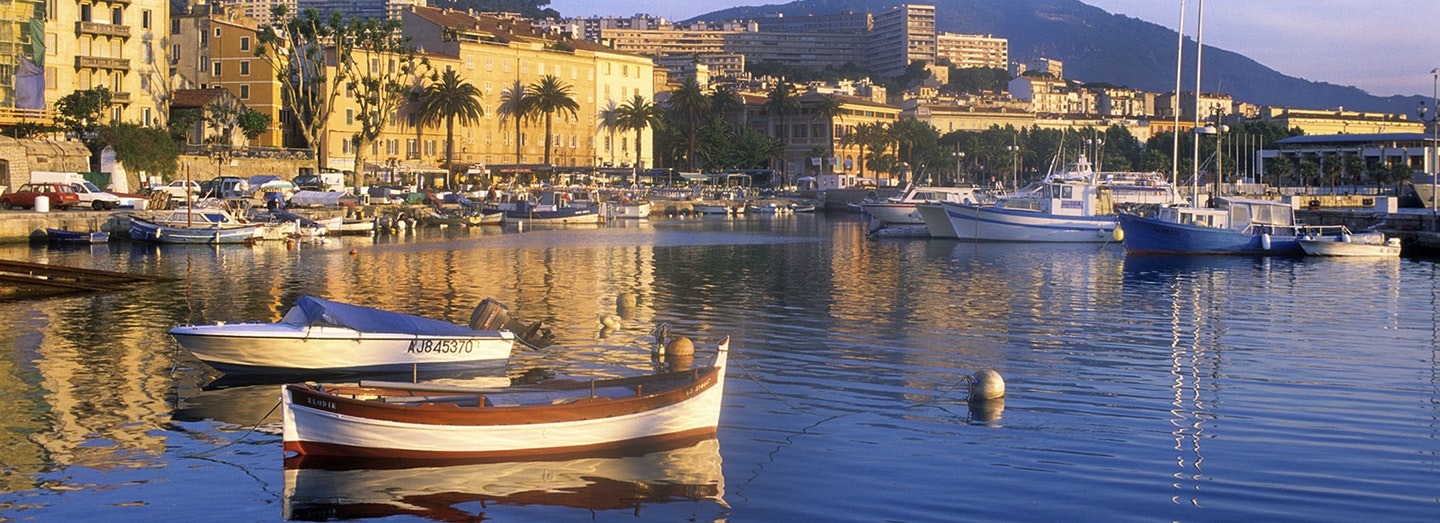
Fesch Museum
After arriving at the train station in Ajaccio, we dropped our luggage at our hotel and headed for the Fesch Museum. The entrance was inexpensive because I think that half the galleries were closed as the tourist season was ending.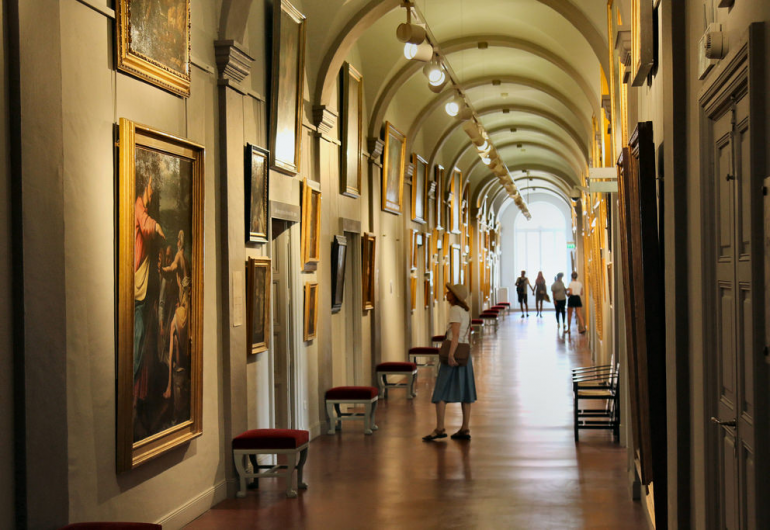
Fesch Museum Gallery


Two Madonnas look modern to me


St Jerome and then how you stroll in Venice
Dawn:
We had been going to pretty nice restaurants, having some fabulous salads for lunch and everything from pasta to fish to meat (once) for dinner. Tonight we were looking for a casual pizza place. Compared to the bustle of cafes, stores, bars, and restaurants in the afternoon, the town seemed kind of dead after 8:00 p.m. We found a true hole in the wall with three tables and a group of three already eating pizzas. “Pizza Napolitana” seemed like the right idea.
The young pizza chef, server, busboy, dishwasher and everything else greeted us with some English as he must have overheard us speaking. Since the place boasted authentic Neapolitan pizza, I addressed him with my sprinkling of Italian only to find out that he really only spoke French, with a bit of English. The threesome next to us chimed in and we got into the whole discussion of how/where did I learn French, where were we from, etc. This group was our generation, and one of the women was from Corte and had just arrived in Ajaccio on the train today as we had. We all sang the praises of Corte as a town and for its beautiful mountain surroundings.
The other couple had traveled in California and had visited the big National Parks out West. They didn’t have much interest in the East Coast or urban centers. A young man came in who was a friend of the pizza maker and got a pizza loaded with arugula. It seems that he had spent some years in Baltimore, working with a French company, teaching cooking. At the end of the meal, a digestif was offered, and I tried the one made from figs. It was lighter than they often are and very pleasant. It turns out that the woman from Corte had made it. The man in the group, who reminded us both a bit of our Parisian friend Jean, asked us how we liked our president. I said that the French have a very good word for him: épouvantable. (If you don't know the meaning, you will just have to look it up.)
All in all, it was a delightful evening. The Corsican people are by and large extremely outgoing and friendly.
Hotel Kaliste
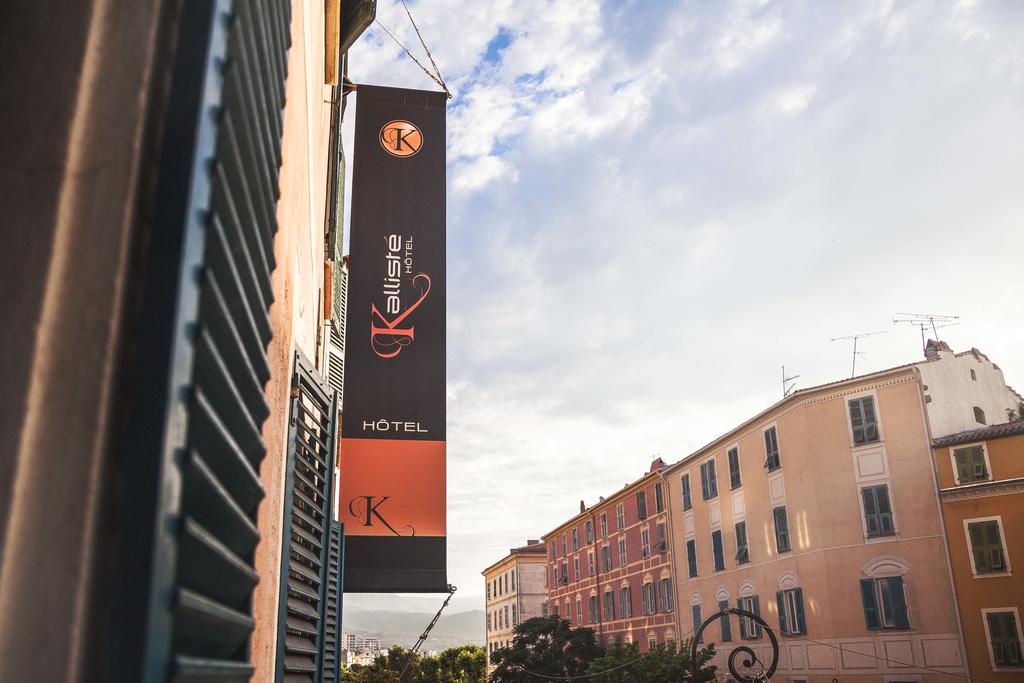
Hotel Kaliste


Dawn in bed, ready to take off and on the elevator on the way out


These tripods were defenses against amphibious invasions. Now, they seem to be protecting seawall that is part of the marina.
Moving on to Sari Solenzara
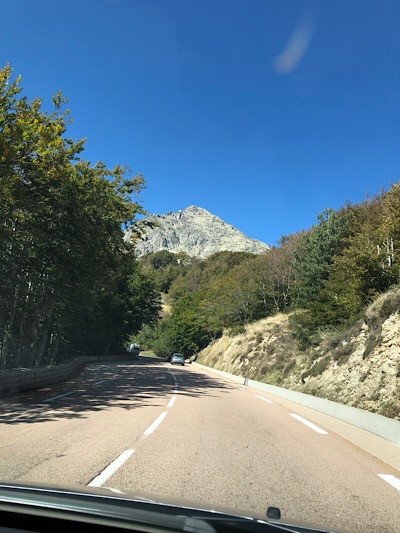
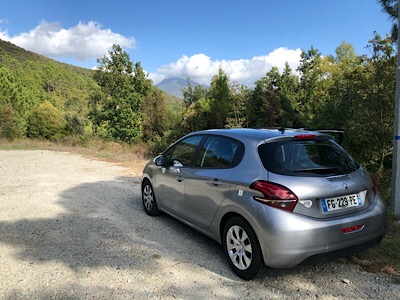
The road to Sari and our car is taking a break.
(top)
Sari



The hike to Monte Santu. Dawn leading the way - a trailmark


Green grown around a small stump with additions. The trail.

At the top, patience rewarded us with a partial view of the Bavelles.
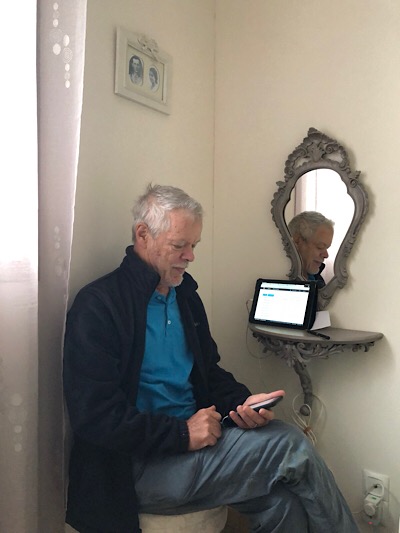
Writing corner. I used the phone to write and the Ipad to manage photos. Right after the picture was taken, I fixed the problem that prevented me from writing on the Ipad.
Stephen:
A few of you may already know, but last May I stopped drinking alcohol. I had been getting more and more irritated by being addicted to drinking. I didn't drink alot but I drank mostly every day and spent a lot of energy controlling my drinking, especially once I started. One evening I read an article in a 2008 Psychology Today Magazine where the author was discussing addiction and Buddhism. The most interesting thing he said was that everything is a choice; you can choose to drink, you can choose to not drink or you can choose neither. It astounded me, and I knew immediately that I had stopped drinking.

As time went on, various hurdles were jumped over: going out to a nice restaurant, attending a dinner party, going to a family reunion. But always lurking ahead was this trip to France where a glass of wine at a brasseries, or a spritz at the end of the day seemed welded into the experience. I am happy to report that I haven't found a time that I need to have a drink. Mostly I have been drinking liptonic, a cold bubbly tea/seltzer combination. The virgin mojito I had was stupidly sweet but the bitters that I found twice was very good. In a restaurant, if I feel that the server is disappointed that I am not drinking their wine or beer, I just tell them it has been five months and their attitude changes completely into one of support and understanding. They might say something like,'oh very hard' or 'good luck'.

I am very happy about all this, especially the comment from Dawn's son, Adam, congratulating me on controlling my incipient addiction to liptonic. Probably, I have to keep an eye on my Agrume consumption too.
Audrey and Eoghan’s Place, (Pronounced Owen)
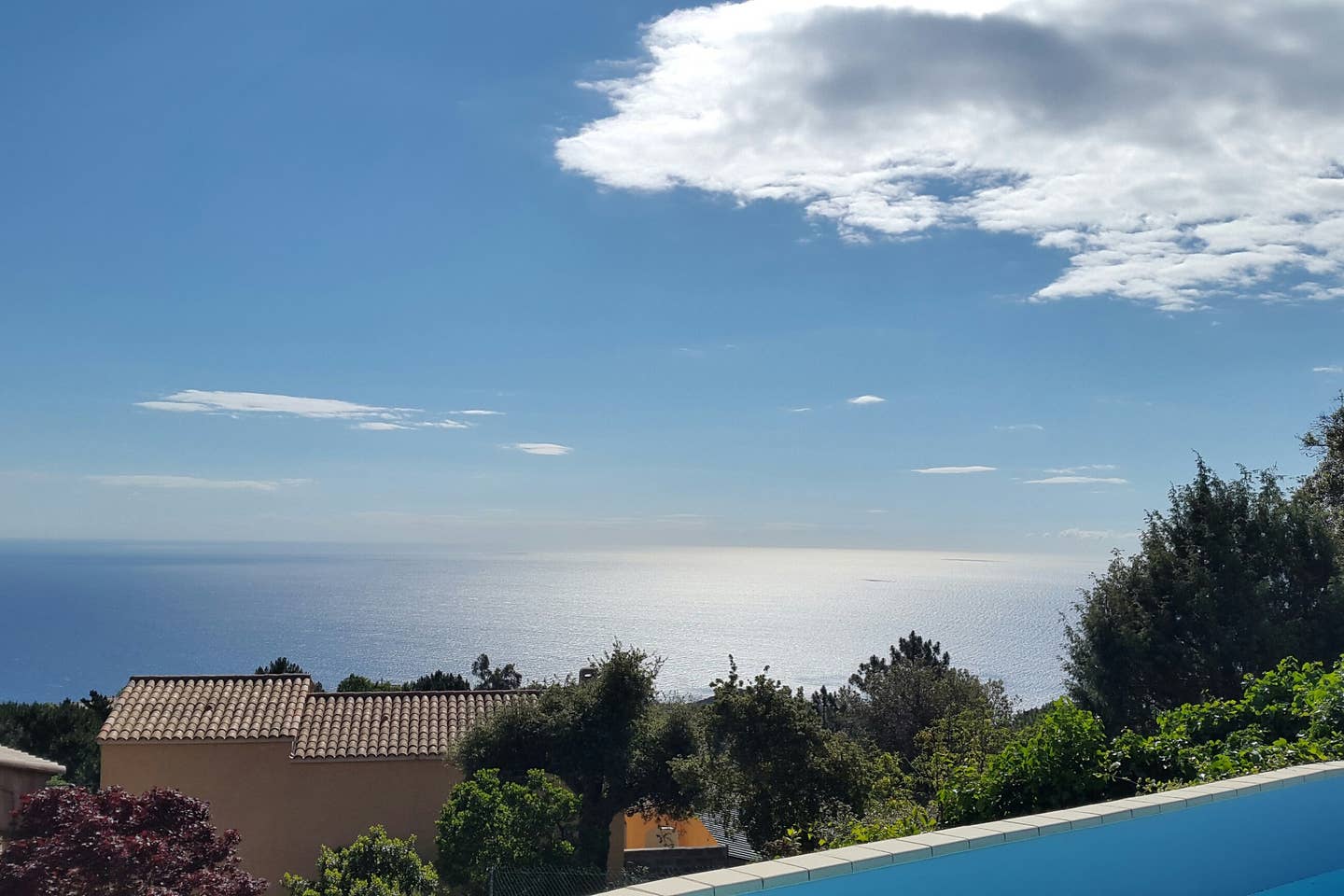
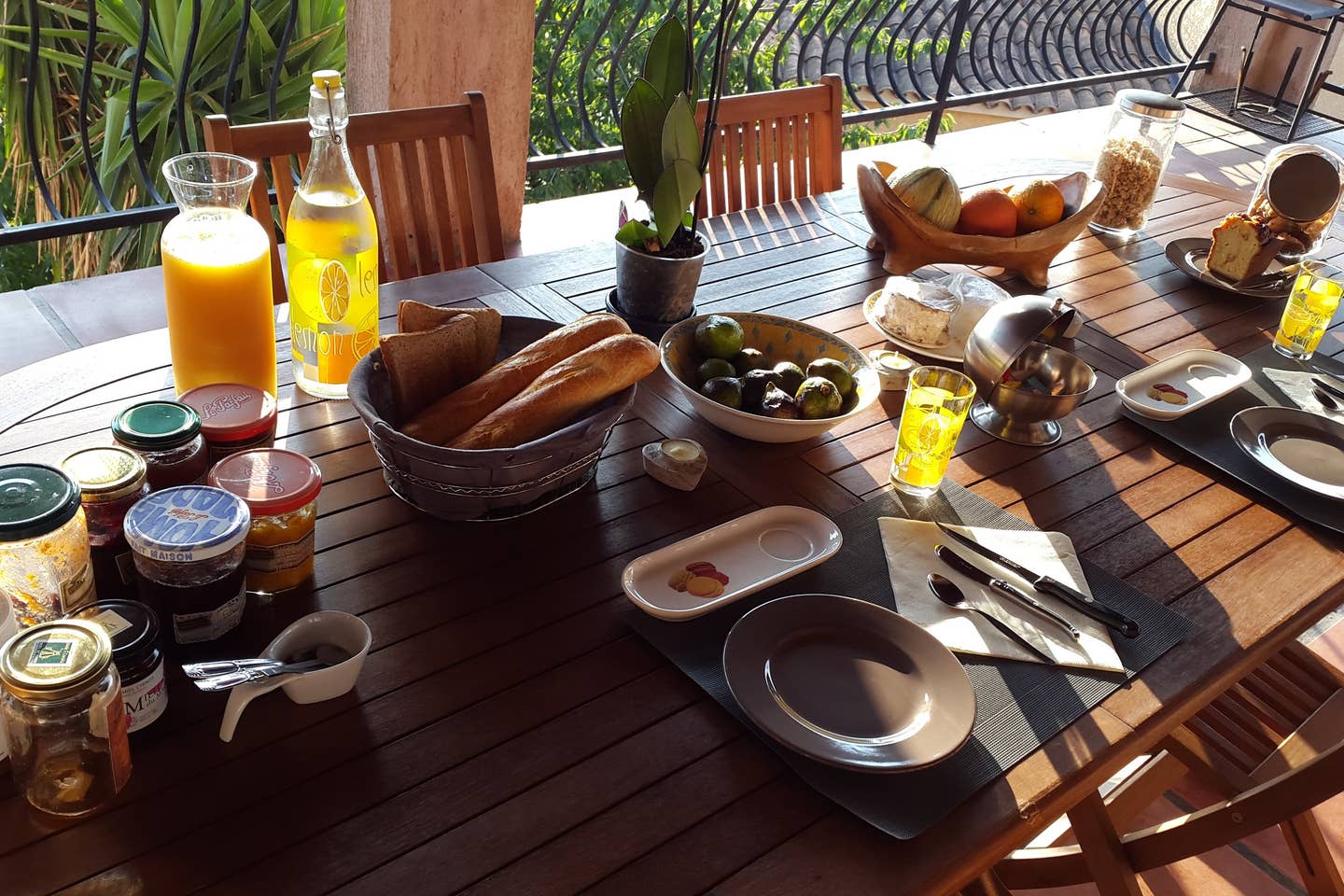
View and breakfast

Dawn:
After a hair-raising fifteen-minute drive of extreme switchbacks, many with no warning, we arrived at Audrey and Eoghan's place, high up in Sari Solenzara, a tiny village. Once again, their home and welcome seems to me to be the epitome of what an Airbnb experience is meant to be. We have a sun-filled room with French Provincial décor and private bath with great shower.
Although they did not advertise doing table d’hôtes, they invited us to have soup with them that evening. I was so grateful as I did not want to do that drive down and back again in the dark on our first night. It was a wonderful, hearty soup of veggies from their garden and sanglier, the wild boar that is ubiquitous in Corsica. A couple of pieces of homemade bread by Eoghan and some strong Brebis cheese we had brought complemented Audrey's soup.
The conversation ranged from everyone’s varied backgrounds to the similarities between Corsica and Ireland. Eoghan is Irish, Audrey Corsican/French. Although they are certainly younger than my own children, there was an immediate bond and mutual respect established. The conversation continued every morning over a lovely breakfast with good, strong coffee.
Stephen:
Eoghan explained to us that the Corsicans held the same place in mainland France as the Irish held in America, especially places like Boston. They immigrated and became the police ... and the criminals, and often were friends. We talked about the Bulger brothers, (they had seen the movie). Audrey talked about Sartène. It is considered in the tourist world to be the most Corsica of cities, but if you live there, you will find it very old school, the society is dominated by old aunts and grandmothers who expect things to go their way. As tourists, we have no way to know about this, except to wonder if the narrow roads that turn into narrow paths represent more than an efficient use of space in a mountain town.
Dawn:
Today we are completely fogged in and "il tombe des cordes." It is falling in cords or raining like cats and dogs. So we are taking a bit of a vacation from our vacation, doing yoga inside, reading, writing, doing some NYTimes crosswords puzzles and chatting with our hosts. Audrey made us afternoon tea, with another slice of the delicious date cake she had made for breakfast.
The Monastery, but actually a convent.

As mentioned in my email, on Sunday we went to Mass at the monastère of the Sisters of Bethlehem. Eoghan explained later that these nuns had been an order in the original Bethlehem in Israel. They left about 25 years ago because of all the difficulties there, and found a beautiful site for their order here in Corsica.
From my email: Although we are both more Buddhist than Christian at this point in time, we love liturgical music, and the relatively simple, modern church is in a beautiful location in the mountains. We arrived a half hour early so had time to settle into our own meditation. When the bells started ringing, with a second lower-toned bell entering as almost a drone, we both got a bit teary. Somehow, the sound of bells or chimes in any tradition seems to be an international language for a call to spirituality.

Stephen:
After spending the day in the deep fog we rousted ourselves out to go down into town for dinner. The first restaurant that we thought might be open was not, so we returned to the marina and found the Port Glacier (Ice Cream). The meal was good and we finished up with some gelato. We have stopped counting handsome waiters with killer smiles. On the way back up the mountain, we sighted the famous wild boar. A family of them were running up the road in front of our car. Quickly they dashed to the side of the road and then off into the woods. The biggest one was a little more the knee height and fairly thin. Eoghan said later that the hunters are slowly driving them up the mountain. They are a staple part of the diet and we have been enjoying them at dinner in various forms of cooking.

Short Trip to Bonifacio
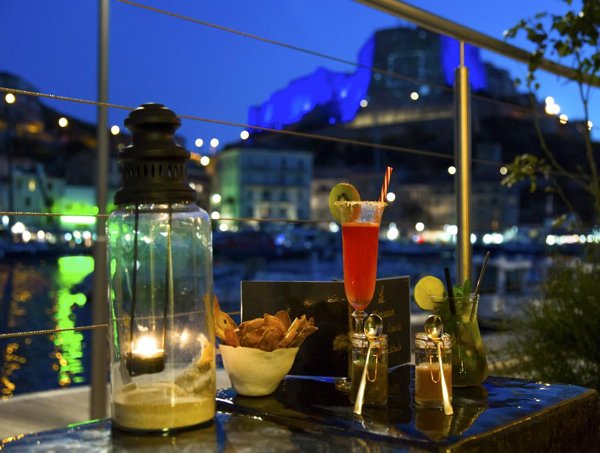
Hotel Solemare
This was easy. We said goodbye. We drove down the mountain on the twisty road that was becoming an old friend. We took the same road that lead us to the beach where Dawn wrote the first email. Then a half an hour later on a pretty straight road we found ourselves at a small lane that said, do not enter except for Hotel Solemare. At the gate, Dawn spoke through the intercomm to the front desk and it opened and we were in.
What I have forgotten is that when I was just a hundred yards or so from Audrey's I heard a loud low-pitched truck horn. I had no idea where it was but I gave a pip-squeaky beep in return. When I got arounf the next corner I found a large truck carrying some telephone poles blocking my way. He totally filled the gap from stone wall to stone wall. But in fact he was waitng for me. He had heard my beep and stopped just before a driveway that I could slip into. Then he lumbered past us and I could back up into the road and be on my way.
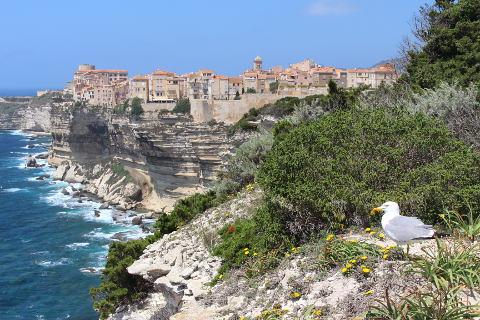
Bonifacio
We left the car parked at the hotel and began our exploration of the town.
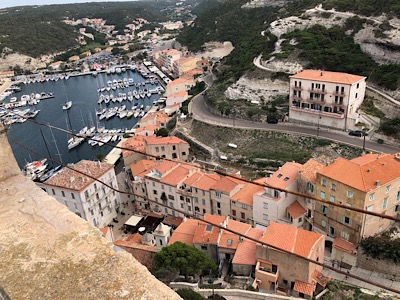

Looking down at the old town and cliffs


Beautiful Cliffs
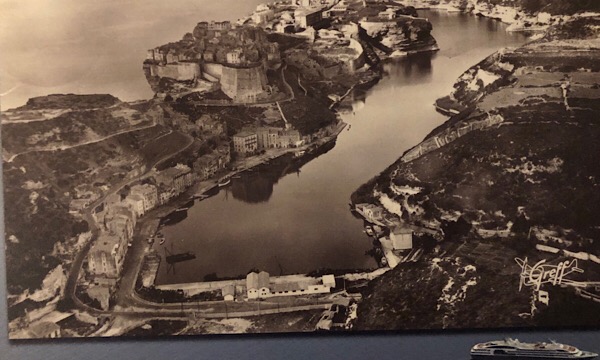
Old photo
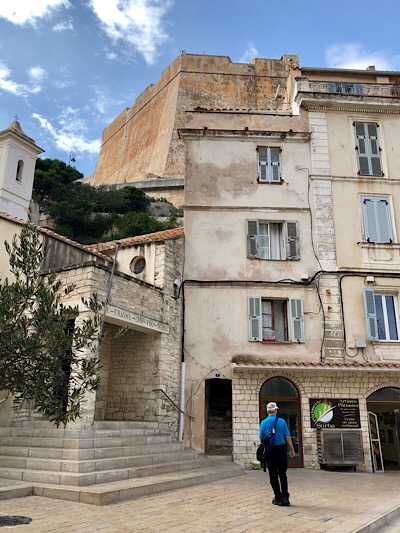
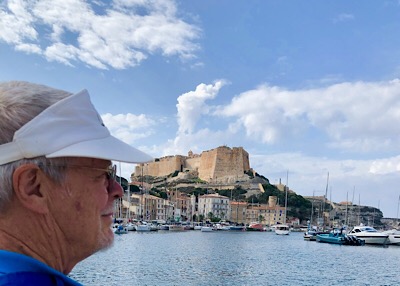
Walking about
Hotel Solemare


From the balcony of our room, Dawn watching the yachts trying to dock. Another port photo.

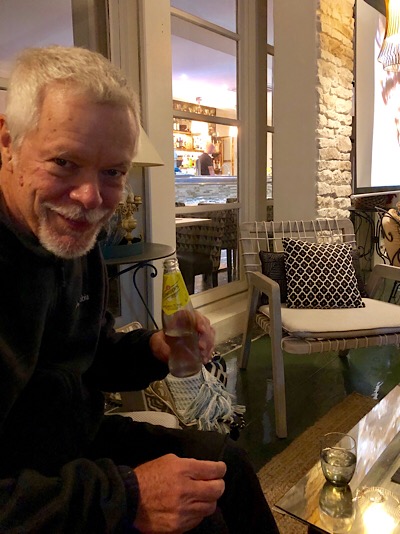
We are in the bar having a nightcap.
Getaway Day

Dawn is at yoga and I am about to take a swim.
(top)
Town of Sartene
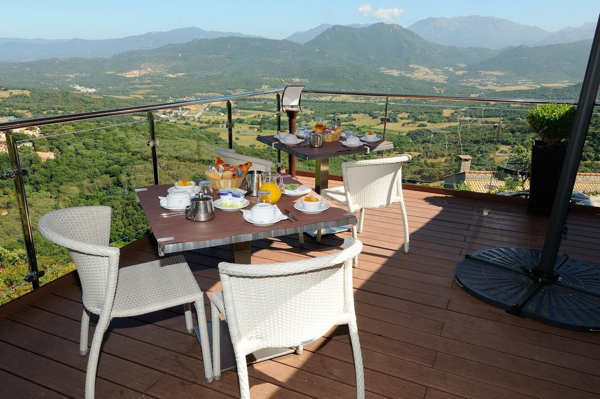

Views of and from the Hotel des Roches, (it’s the building a little whiter than the others).

Choir of Sartene
Stephen:
They totally knocked us out. We discovered the concert accidently by seeing a poster while looking for the prehistoric museum. Five singers, not the six advertised, sang with power, grace and sweetness. They could sing loudly and very quietly, music both sacred and profane, modern and ancient, and then afterwards served us wine, juice and cookies outside in front of the church.
Dawn:
The church was not beautiful, but it was acoustically perfect for these singers. The five men could fill the space powerfully with the vocal polyphony that they have mastered. Although the leader’s speaking into the microphone was too fast with too much reverberation for me to understand much of it, and although I didn’t understand many of the lyrics in Corse or French, the actual SOUND of the music made me feel deeply the history, the spirit, the passion, the intelligence of Corsica. It was incredibly moving. It made me fantasize about doing a site-specific video with their music and the menhirs at the prehistoric site Filitosa that we were going to visit the next day.
Filatosa
Filitosa was fascinating with ruins of prehistoric shelters as well as the mysterious large, standing figures known as menhirs. Estimated at 6000 B.C.E, the homo sapiens who inhabited these shelters took advantage of Nature’s carving of the rocks by added stones to create a small village. There were scores of possibilities for video: a figure half hidden and emerging from the fabulous rock formations, 'dancing' with the menhirs, inhabiting the massive olivier that they claim to be the oldest tree in France. However, I felt like I would essentially be repeating what I have already done in other wonderful locations so decided not to make any performance videos here. Perhaps I have done enough. Again that feeling that the world does not really need another Dawn Kramer site-specific performance video.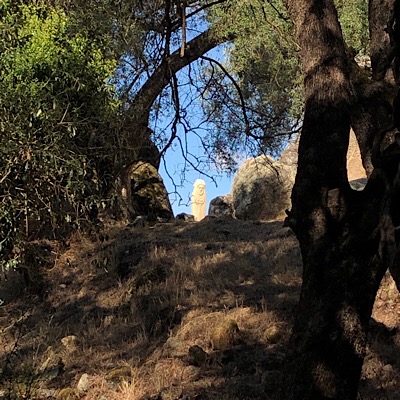

A beautiful Menhir.
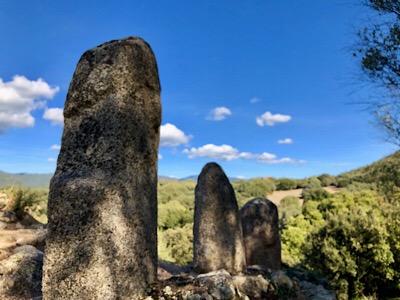

Single menhir and the oldest olive tree in France.


Living quarters. Who knows what they looked like when they were occupied.

Another place to live, not yet an Airbnb.
Prehistoric Museum
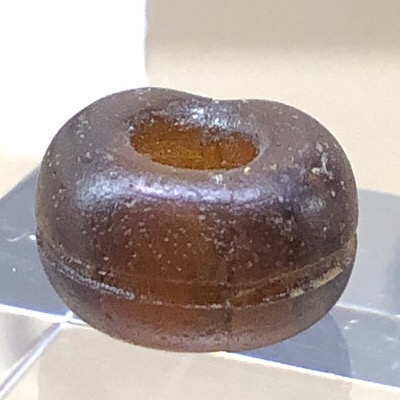

A small piece of Amber and a small bust


Cups


Cups and ewers


Menhirs
Last visit to the Beach (Cupabia)

We like the beach.



A large beach with a small parking lot. Stephen swam, for Dawn it was too windy.
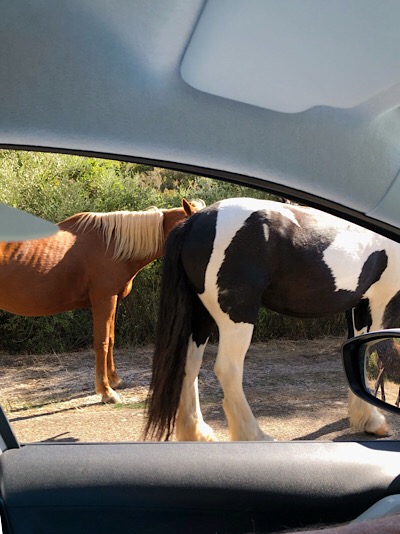
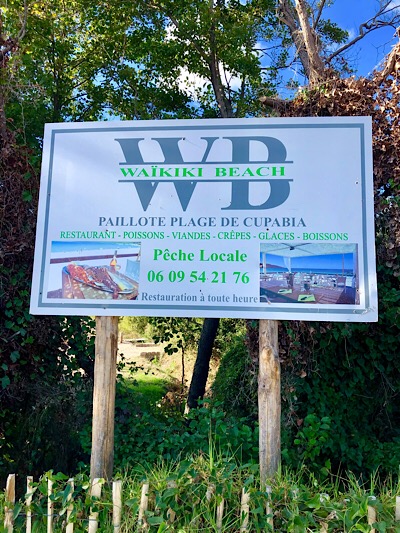
Horses sharing the road with us and then an odd sign. They were being lead by a woman who was driving a car holding the reins of ahorse out her window.
Restaurant du Cours - Wrapup on Corsica
Dawn:
So we decided against eating at the fancy restaurant in our hotel and found the Restaurant du Cours with Corsican specialties. From the photos, you can see that it is very much our style, a small place built into a real cave. It made me think of our friend Joe, the proprietor of Sophia’s Grotto in Roslindale. Joe’s Grotto was designed to look like the real grotto that we were eating in on our last night in Corsica. The food was great and copious. I had courgettes stuffed with Corsican cheese and fresh herbs, after a huge salad to start. Stephen had another Sanglier stew, this one better than the last. The server wondered what we Americans were doing in Corsica, something we are often asked.
By some odd coincidence, on our second gray, rainy evening in Paris, we found a wonderful documentary on Corsica on French TV in our Airbnb apartment. The travelers in the documentary visited many places that we missed. So I have a suspicion that we might get back to Corsica in the not too distant future. After all, at this stage of life, one never knows if there will be a distant future.



Two shots of the signs and a picture straight in.


What we drink. Dawn's a myrt, a digestif made from blueberries. Mine is the local bottled fizzy water.
Hotel des Roches
We spent our last two nights here and were pretty happy. Once we got the powered shutters up, we saw the great view down to Propiano and the ocean, and had a balcony from which to eat our clementines and watch the sun go down. After some back and forth, we decided not to eat at the upscale restaurant with a great panaramic view of what seemed to be most of Southern Corsica. In the summer, there would be light at dinner, but in mid October, it would be dark. The room was not spacious, but it had what we needed, shelves and a closet and a great shower. We also had room to pack for the airplane. The staff was great, even finding us a brush and dust pan so we could get most of the sand out of the car before we returned it.To the airport
The reason you shouldn’t have breakfast at the hotel is that the local cafe/bar will offer much more interest. You just hope that you are not taking the table that some guys have been sitting at for the last ten years. The proprietor said yes to our order of two cafe cremes and that he had some pain au chocolat. In a way, because five minutes later we saw him returning from the bakery with our food. The comings and going are fascinating and we could have stayed all morning, but we had a plane to catch.We drove for an hour and a half, did a total elevation gain of 1,600 meters and came down 1,900. I think we did a thousand curves, all through really beautifully country. We would drive for fifteen minutes without a sign of humanity, and then ease through a country village clinging to the side of a mountain. In one villlage, the national highway (one lane in each direction) went down to one lane total. The traffic light alternated traffic one way and then the other. We topped up the gas before we returned the car and were soon in the airport with time to spare. A slow coffee, getting our bag ticketed, hanging out, meditating took care of those minutes. The plane was twenty minutes late which is not late. Next stop in the Travelogue is Paris.
(top)
Paris, October 18 - November 1
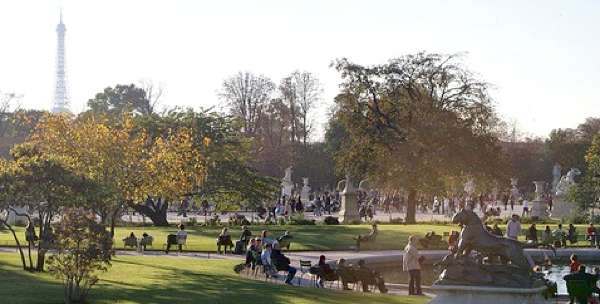
Paris in October
Our Arrival
Stephen:
We began to wonder whether we are getting too old to be traveling this close to the ground. Getting from the Orly airport to our apartment took forever. I missed my bag on the carousel because it was wrapped in plastic by the crew in Corsica and I wasn’t able to identify it. The walk to the tram line 7 was endless. The metro ticket machine didn’t like our credit card and needed to be coaxed to work. The tram was slow, the metro was crowded, my backpack had to be rested on my knees. In order to transfer to line 11 we needed to exit the metro and walk down to Hotel de Ville on the street because of a station renovation, and finally a short walk through some street construction to the apartment. Marie-Line was out on the street waiting for us and the rest of our day was easy.
The White Rice Restaurant

Piano Concert

Dawn:
Yesterday we returned to the Armenian church in the Marais where we had heard spectacular piano concerts two years ago. This time, the artist at the keyboard was a young Japanese woman, Assami Watanabe. She played an extensive all-Chopin recital, completely from memory. Wow! She did not disappoint. This pianist had a beautiful sense for playing romantic music, the timing and dynamics so heartfelt and precise. Her performance made me think of the passion, dedication, practice and hard work that any artist needs not just to excel but also to make a deep connection with her audience.
Musée National des Arts Asiatiques - Guimet
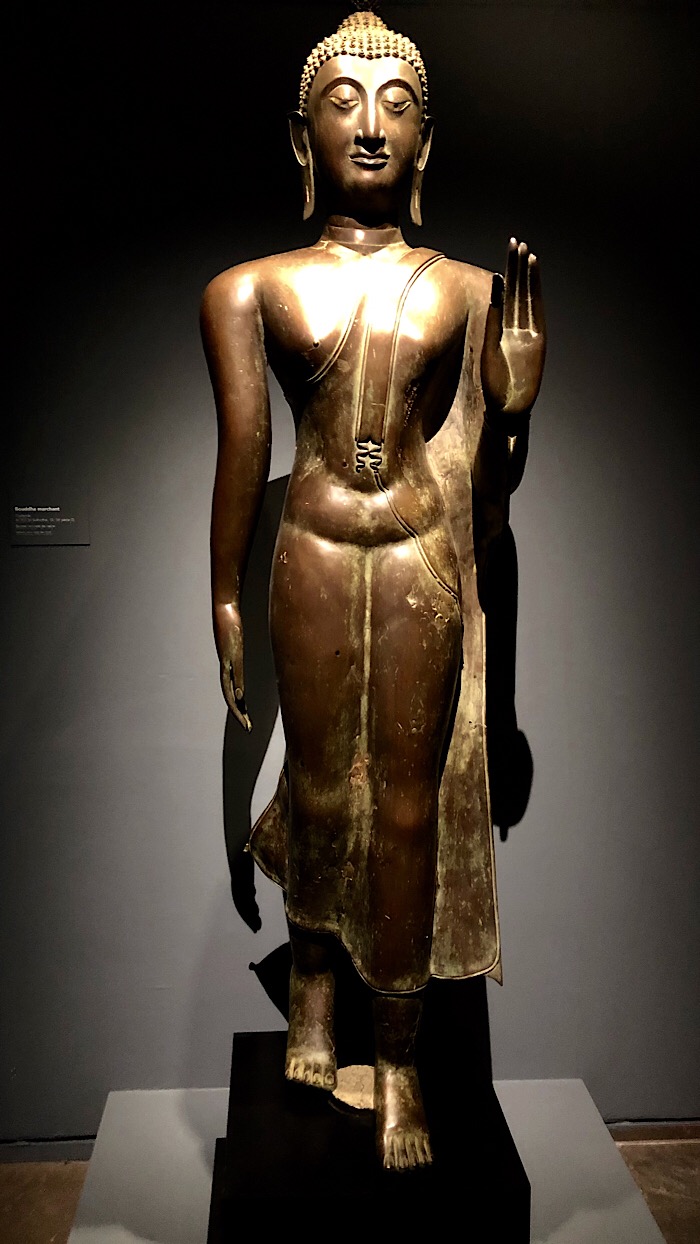
A walking Buddha, and I would say a young Buddha. His physicality is unusual.
Dawn:
Today at the Guimet Museum of Asian Art, I had the same feeling. Looking at the astonishing craft/art of potters, inlaid cabinet makers, sculptors and painters over centuries, I was again impressed by the dedication and practice it takes to create really fine art. There was a special exhibition on the life of the Buddha with an extraordinary collection of Buddhist art from a couple of centuries B.C.E to the present day. A centuries old bronze, seated monk seemed to breathe as I stood before him.

Dawn:
The most moving contemporary piece was by Takahiro Kondo, an artist who mixed porcelain, silver,glaze and other materials on his own body as he sat in a yogic meditative pose. He must have had an assistant carefully bisect and remove his full body cast which then became an independent sculpture that had an elegance as well as a feeling of death about it. The piece is a memorial effigy dedicated to the 18,000 people who died in the Fukushima tsunami and nuclear disaster of 2011. To paraphrase the curator, the artist manifested the image of life as the image of death. The artist manifested a profound versatility based in the tragic and universal grandeur of an ambivalence that is totally Buddhist in spirit. I was again moved to tears. The piece so clearly referenced the scores of old sculptured seated Buddhas, but it was thoroughly contemporary and startling at the same time.



Stephen:
I guess I see acceptance, but as an embodiment, not a concept. Lately I have been seeing doubt in him. This was after I enlarged the photo. Maybe he has a question. His asymmetrical eyes gives him a real personality. If he were to speak to me, I think he would tell me that I am trying too hard. Maybe he would just smile. I think it would be beautiful.
Click here to see more of our Guimet Museum Photos
El Greco at the Grand Palais

Dawn:
El Greco is one of my favorite old artists (1541-1614). Many years ago, when my son Adam and I traveled in Spain to celebrate the year when I was exactly twice as old as he, we were both captivated by El Greco's mannerist paintings that we saw in Toledo and at the Prado in Madrid. His elongated figures, intense colors and wild skies embodied the passion of subjects and artist. Here at the Grand Palais, there was an extensive collection, lent by museums and collectors worldwide, that showed us his growth and change as an artist over time. The Pièta is rarely seen as it is owned by an unnamed individual. Although not typical of his high mannerist style, it really got my attention because of the intense feeling expressed in the faces,especially between Mary and her crucified son. While I am not a Christian anymore, I certainly am a mother and grandmother. To witness the death of one's offspring must be one of the most difficult experiences to endure. Also the physicality, the detail of the hands, was so palpable. I stood in front of that painting for a long time.


Le Voyageur
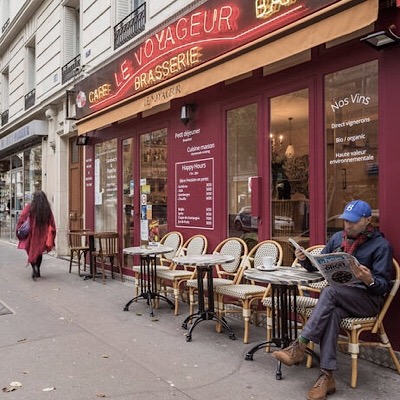
Dawn:
Paris is a little sad this time. We know that everything changes, but sometimes a change takes us by surprise so takes some getting used to. Yesterday we stopped by the Voyageur on rue Parmentier, mostly to see the owner whom we have gotten to know for a few years since renting apartments in the 11th. The minute we saw the new front of the café we knew something had changed. Mo'ammed, or Momo as he was called by friends, left the business about a year ago. The current, very nice young owner said he had no way to contact him, that he had gotten tired and probably went back home to Algeria.
When we had gone to Le Voyageur before, we were always the only non-Arabs in the place, and often I was the only woman, although there had been a young woman who helped Momo for a certain period. We had good conversations with him, about the universality of music and dance and the ability of the arts to bring people together. When we went to Morocco, we sent him a postcard which he kept at the café and showed us on our subsequent visit. Being Algerian, his voice and way of speaking French reminded us of our dear friend Malek who died in 2015. It's not like we were close friends that kept in touch outside of our visits, but it was an honest, mutually appreciative connection that is now lost.
Notre Dame
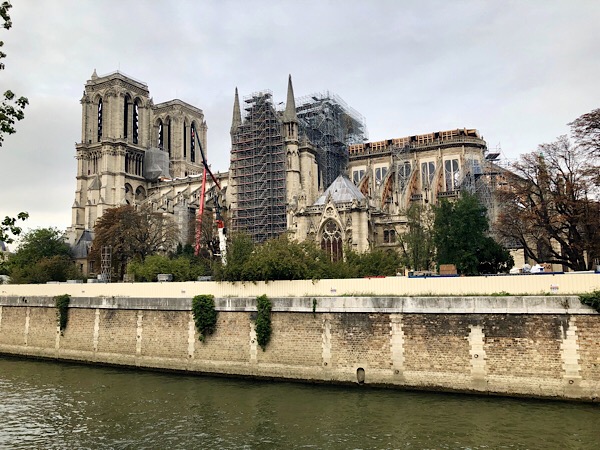
The First Day at the Voyageur (from 2015)
Below is what we wrote about our first meeting at the Voyageur four years ago. We were surprised by his sympathy for Dawn.
Stephen:
A couple of days ago, I let Dawn go back to the apartment and dropped into a bar near the apartment for a Guinness. I have enjoyed the beers I have been drinking but missed my Guinness. In France, the accent is on the second syllable. I managed to make myself understood. There was a paper on the bar so I worked through a couple of articles, paid my tab, checking with the patron that 3 Euros 40 was the right amount. It was bottled Guinness and was okay but not as good as a draft.
The next day we ran out of coffee and it was necessary to go out. Le Voyageur may be the name of this place, it is what is on the mirror. I knew it had stools at the counter so we stopped in and ordered deux café crèmes. he was very solicitous about Dawn’s arm and breaking the sugar tube and pouring it into Dawn cup. He was on his way to putting a second in when I stopped him and he gave me the opened tube. I had to put my own sugar in.
"Did you want a croissant"? he asked.
"Pain au chocolat?"we responded.
He said he would be right back and went to the corner to pick them up to where we usually buy our baguettes. He mentioned that he was providing this service because of Dawn’s injury. Otherwise, you get sent out to get your own when a place doesn’t have them or has run out.
So I think he has now recognized me from the previous evening and so he goes over to the place where I had been sitting the night before and acts out my, to his eye, surly and unresponsive body language as he had been trying to joke with me. Dawn finally told him that I speak French better when I am with her and he finally understood that I don’t speak French and that I am not really a curmudgeon. We went on to talk about the ways that different coffee preparations are described in different languages. In the end we paid, 8 Euros 40, and left.
Le Petit Cardinal

Stephen, Dawn, Ophelia, Réné and Pascal
Does anyone wear white anymore?
Dawn:
We have kept in touch with Pascal, the young man who took care of our first Airbnb rental when we arrived here in 2015. He is also a writer and friend of the artist, Bruno Pierre whose studio we have occasionally visited. We met at le Petit Cardinal where we often had a drink together before. Pascal was lamenting the change of ownership. Yes, everything changes, here in the fifth arrondissement as well as with le Voyageur in the eleventh. This time we got to meet Pascal’s lovely wife Ophelia and a good friend of his from Holland who had come to Paris to go to a concert by David J from Bauhaus, a group that the two guys really liked. They are basically my children’s generation. I am not really sure why Pascal still likes to hang out with us occasionally. Maybe he is just being polite. In any case, we always enjoy finding out what people of various generations and cultures are interested in. They are all very much into wearing black, and we happened to be black-clad that day too. When I sent Pascal the photo, I captioned it "Does anyone wear white anymore?"
The Belleville Market
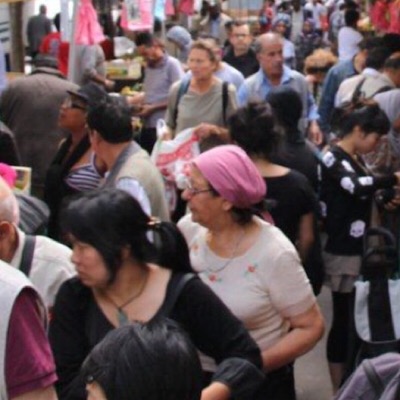
Stephen:
Tuesday morning we headed over to the Belleville Market. It runs along Boulevard de Belleville and is just two blocks from our apartment. It is generally touted as the biggest, best Paris outdoor market for having the lowest prices. It is all that and more. Most of the city of Paris seemed to be in attendance. Not only did it seem that there wasn't room for us to get down the sidewalk, I had no idea how I would purchase anything in this throng. I grabbed a picture off the internet, but it doesn't do justice to the throng in attendance.
So we extricated ourselves and went to a small shop along to buy some olive oil and nuts, then walked along the boulevard for a few blocks and dove back in, hoping for a less croeded area. No luck. We came out again and found a place th buy gargage bags, tonic and other staples. Then we went home.
I write about this to share what I consider a failure in our attempt to be travelers rather than tourists. We should be able to dive in to the local experience, to throw off our incipient claustrophobia and jump into the crowd and figure it out as we go. It might be that we are getting older, but I want to fight the psychological aging even as I must give in to the physical part. My plan is to ease back a little, go to the more sedate markets of Paris, maybe ride the bus when we travel from the airport into paris, rather than three metro lines, with all their stairs, at rush hour and just travel in a fashion that is a little gentler on us.
Two and a Half Short Stories

Stephen:
We got a forecast of a couple of hours of sun, so we hurried out of our apartment and headed for the Luxemburg Gardens. The bus was crowded, but we found seats in the very back with me sitting on the center seat. We had one more stop to go when Madame Driver turned around and in a loud commanding voice demanded,
"Monsieur, descendez immediatement", and then she added (still in French), "Hey mister, you with the hat, get off my bus now." (I recognized chapeau). Now I looked around and didn’t see anyone wearing a hat, except me! People began to turn around and look at me and began to make gestures like I should do something. So I did. I got up, walked to front of the bus and asked her, "Why?" (Pourquoi, another word I know). She didn’t respond and seemed to be looking past me. I turned around and saw the guy she had been yelling at all the time. He was slunk in his chair trying to pretend he wasn’t there. I slunk away, and Dawn and I sat down in the front and realized his sin, he and his friend stunk to high heaven, pungently and powerfully. She kept insisting and finally he slunk off, his friend following behind.
Moments later, the doors opened at our stop, we escaped to another bus that took us across the Seine to the Gardens where we found chairs, examined ourselves for wounds and finding none, we took this selfie to prove that we were okay. Which we really were.
Dawn:
When the bus driver first started asking the man with chapeau to get off the bus, and everyone around us started looking at Stephen, I imagined they thought that we had asked the driver to let us know when we were nearing a certain stop. Madame driver did have a scolding tone in her voice though. Of course I went with Stephen to approach the driver. When she looked past us at the two men with chapeaux sitting closer to the front and demanded that they descend, the reason became olfactorily obvious. Although relieved that she wasn’t reprimanding us, it still felt a bit weird to have momentarily become the center of attention in a public setting like a bus.
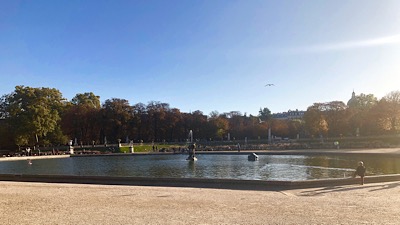
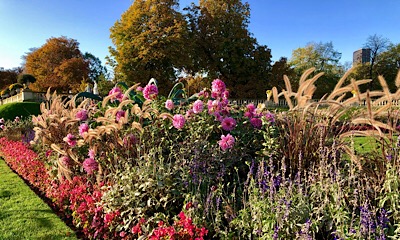
Luxenburg Garden
Dawn:
When we got back to our apartment building, the building manager, the concierge and a couple of tenants greeted us with yet another reprimand. We had brought our recycling down to the proper receptacles but couldn’t find a bin for the regular trash. We noticed a small, sealed bag of garbage left on the floor next to the recycle barrels, so we did the same. Apparently our Airbnb host forgot to tell us to use our front door transponder to open a different door in which to dispose of the garbage (or we missed it),.The manager said he saw us leave our bag in the wrong place, as if we had committed a major crime. We both assured them in our best French that we now understood the proper procedure. We slunk up to our ninth floor apartment, tails between our legs. It was not our best day in Paris!
Stephen:
A day or two later, we are in the recycling room dutifully putting the paper in the paper bin and pushing the bottles through the holes on the top of the glass receptacle when, Sacre Bleu, I put a plastic bottle through where only glass should go! The lid is locked so we can’t fix it. Dawn wants to skedaddle, but they will know it is us.
Dawn:
Stephen says that we have to tell the building manager because he will know that we are the culprits anyway. I plea for just leaving it alone since, after all, I am the one who has to do the communication. Of course I realize that Stephen is right so we go back, up to the office window to talk with Monsieur, the building manager. I explain that we are terribly sorry but an accident happened while we were putting the glass bottles in the glass recycle bin. (BTW, try saying the French word RECYCLABLES in French, not English. It is not easy to pronounce!)
Stephen:
He shakes his head sadly as if our sin is unrecoverable, but he takes his key and opens a panel behind which he finds another key. When he pulls out a pair of rubber gloves on and I know we are saved. We process back to the recycle room and he put the key in somewhere and opened the top, then he put his gloves and extracted the offending plastic bottle, opened the paper and plastic bin and placed it in. His work was done, the world was righted, God was in his heaven.
Dawn:
As we were walking out, he asked us when we were leaving Paris. I guess he is looking forward to our departure. He did ask where we were from, and we discussed the various ways of recycling. I mentioned that in Boston, all recyclables go in the same bin. We also discussed the various methods in other parts of France. Finally we wished each other a bonne journée and departed on a civilized note. Phew!
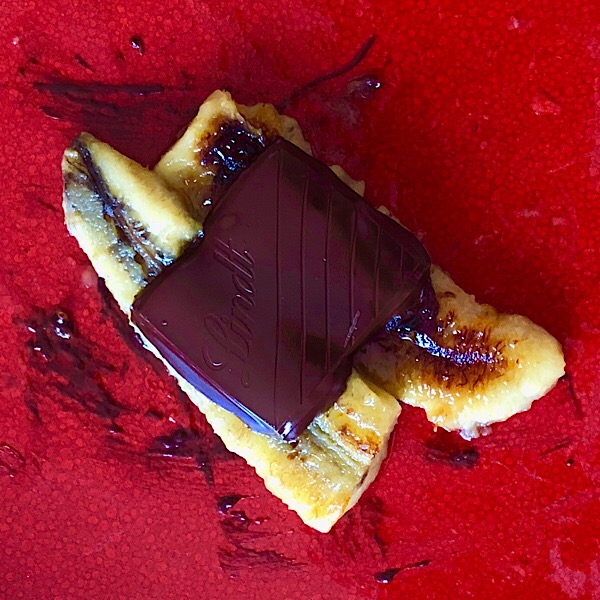 Stephen:
Stephen:I think we have an end to this series of stories. As we were saying, we got instructions to go through other door, which we then followed on our way out but couldn’t find the poubelle. We found the underground garage and saw on a map where people’s caves were (where they stored their wine). We took our little bag of garbage back upstairs and later contacted Marieline for more instructions. She sent back the code. The next day on my own, I took the garbage back down with some recycle, dropped off the recycle, got back in the elevator pressed the -1 button, and after a hesitation, it took me down. When I got there, a man was waiting to go up. I held up my bag and said, "Ordure?" and he pointed around the corner and ascended up in the elevator. Victory!, but with a question. Why did they tell us to take the stairs using the door transponder, instead of just using the elevator? This question was answered the next day, when, while recycling some stuff we noticed another small black garbage bag just like ours on the floor. We were worried that they would blame us, unfairly this time, so we grabbed it, went into the elevator, pressed minus one and nothing happened. So we had to go out and through the other door and down the stairs to get to the garbage. Obviously, the time before the man had called the elevator and that’s why it seemed that I could take it down myself. I think we are finally done with this story. The photo of Dawn’s desserts made at home was added because we needed some color in here.
Paris, A Day in
Stephen:I was sitting on the toilet when Dawn’s question floated in from the other room "Do you ever look at me and think that you don’t really know who I am?" This was followed by, "Sometimes when I look at you I wonder if I really know you. Of course I know you, but do I really know you." I pondered this for a while and replied that one way to ascertain whether you knew someone was whether they surprised you very often. When I try to say who someone really is, it just seems like words. Somewhat surprisingly, I can’t say that I know myself any better. Later today, self knowledge will come into play in a big way. The day was about to show not only how little (but also how much) I knew myself.
We attended a choral music concert at the Eglise Madeleine. The group was from the Netherlands, I will omit their name for their protection. They kind of wandered up onto the steps to sing, they wore all kinds and colors of clothing, stood in all kind of postures, held their music haphazardly, introduced their performance first in Dutch, then in badly translated English, but not in French. There was no program. The accompanying organ overwhelmed their efforts. Those who sang did so casually. The one good soprano was the whole section herself, Some looked around while they were singing. I admit that the one song that they all knew went well.

Mercifully, it was short. Afterward, the French couple behind us was outraged that no one spoke French to them. Dawn commiserated with them in a battle of facial and upper body gestures of umbrage.For me, an element of wrongness had been introduced. I believe in right and wrong, but I try not to have that judgment be the first way I look at a situation. But this choral group had awakened, oiled and exercised my need to judge. There would be consequences.
After the concert, we found a cafe/pizza brasserie and had a drink. I had a Schweppes tonic in a wine glass rather than a tumbler with a straw. When she set it down in front of me she said, "Like Champagne". Because the performance had been such a disaster, I looked up another one on my app and found a 7 PM concert. We walked five minutes, took two busses to Îsle St. Louis, walked around the corner and we were there.

The room was small, the chairs close together, the piano-forte up in front, on the floor level. Okay so far. There was a photographer. He had a strobe on the top of his camera and occasionally he would get up, walk around and take pictures of the empty stage. It would flash three times in quick succession, the first two to close the subject’s iris to prevent red eye, then the third would illuminate the subject as the shutter opened. The camera had a focal plane shutter. It makes a lot of noise and most photographerrs use an iris shutter when shooting in situations like this. This camera went sort of Flash-Flash-Flap-Flash-Flap Sometimes he would shot a coupe in a row:
Flash-Flash-Flap-Flash-Flap-Flash-Flash-Flap-Flash-Flap-Flash-Flash-Flap-Flash-Flap
This was not so okay.
The door was shut with kind of a bang. Perhaps we would start. Then more people entered, the door banged behind them. Then more people, the room was pretty full. The presenter came out and introduced the music and the performer. It was in French, but I understood enough. It was going okay until the photographer stood up and he
Flash-Flash-Flap-Flash-Flap-Flash-Flash-Flap-Flash-Flap-Flash-Flash-Flap-Flash-Flapped her.
The performer entered and said a few words and she got
Flash-Flash-Flap-Flash-Flap-Flash-Flash-Flap-Flash-Flap-Flash-Flash-Flap-Flash-Flapped also.
This was beginning to go downhill. I felt an unease in the audience, or at least in me. She finished the first piece. The forte piano is a predecessor of the piano and can have an off putting sound if you aren’t used to it. I wasn’t used to it and it sound was irritating.
The first piece ended and the door banged opened and more people came in and tried to to find seats. She started to play her next piece anyway. Discussion arose in the audience about the seating and people banged into their chairs. All this seemed wrong. I began to notice a kind of hesitancy in her playing. I assumed it was in the music, but doubt was creeping in.
She finished. I knew what was coming:
Flash-Flash-Flap-Flash-Flap-Flash-Flash-Flap-Flash-Flap-Flash-Flash-Flap-Flash-Flap
I tried closing my eyes and putting my hands over them to no avail. The strobes seemed to be coming in through my skull. Strobes can trigger seizures in epileptics. Had I become epileptic? She had finished another piece and started a lengthy explanation. A whispered argument broke out in the audience then much schushing and general noises of disapproval. Loudening whispers for him to leave filled the room. All the while, she was still talking. Finally he got up, declared that he would leave, and with his shopping bags in hand, did so. Oh boy.
And of course while this was happening she was talking, so:
Flash-Flash-Flap-Flash-Flap-Flash-Flash-Flap-Flash-Flap-Flash-Flash-Flap-Flash-Flap
Was he an epileptic? I was totally sympathetic and if I hadn’t been so far from the aisle, I might have left with him. I am not an epileptic, nor am I claustrophobic, but I seemed to be acquiring these traits. I do have a pinched nerve in my neck, and sometimes I need to drop my head forward to relieve the irritation. So here I am, cowering in my seat, head down because I can’t see the the performer anyway, hands covering my eyes, hoping for it all to end. The concert goes on, another piece ends. In my cowering state, I know what’s coming:
Flash-Flash-Flap-Flash-Flap-Flash-Flash-Flap-Flash-Flap-Flash-Flash-Flap-Flash-Flap
The concert ended, but not my ordeal. The performer talked, then the presenter, then both in a kind of Q and A. The camera guy was in heaven. He fired away. In front of them, in back, this side, then that. I just waited. It would be over. I was helpless in front of this assault because all I could see and feel was the wrong of it, and so the evening grabbed me in a way that wasn’t necessary. As someone said, "It was real, but not true." So, even though I was having a crazy, crazy reaction, I wasn’t going crazy. Part of me was watching myself. Noticing, but without the power to make much change. I knew who I was, and this wasn’t it, but I was going to have to live with it for a while. Once we got out of the building, my anxiety quickly subsided. I was free.
On the way home, we took a turn and walked down a street that came to a dead end. There was a large gate and a sign, "Prive". So we just walked back. I turned back to see the entrance to a club. It was called "Impasse". Not today. The next street took us home.
The Silence of Movement at Pavillon Carré de Baudouin



Interactive sculpture, "Emergent", by Justin Fiske. The devices on the white stand allowed the audience to move the little "planets" that hung by threads in different ways.

Kinetic sculpture by Laurent Debraux. The tree rotated in three different sections when people moved toward its placard on the wall.
Music: "Watching the White Wheat" (trad. Welsh) Arranged/performed by Eden MacAdam-Somer on her solo album "My First Love Story" https://necmusic.edu/faculty/eden-macadam-somer
Scupture: ADA - analog interactive installation kinetic sculpture post-digital drawing machine by Karina Smigla-Bobinski. https://www.smigla-bobinski.com/
I thank both artists for their beautiful work and their permissions to use them in this short piece. Click on their links above to see more about them.
More about ADA
Similiar to Tinguely’s ‘Méta-Matics’, is "ADA" an artwork with a soul. It acts itself. At Tinguely’s it is sufficient to be an unwearily struggling mechanical being. He took it wryly: the machine produces nothing but its industrial self-destruction. Whereas ‘ADA’ by Karina Smigla-Bobinski, is a post-industrial "creature", visitor animated, creatively acting artist-sculpture, self-forming artwork, resembling a molecular hybrid, such as a one from nano biotechnology. It developes the same rotating silicon-carbon-hybrids, midget tools, miniature machines able to generate simple structures.
‘ADA’ is much larger, esthetical much complexer, an interactive art-making machine. Filled up with helium, floating freely in room, a transparent, membrane-like globe, spiked with charcoals that leave marks on the walls, ceilings and floors. Marks which ‘ADA’ produces quite autonomously, although moved by a visitor. The globe obtains aura of liveliness and its black coal traces, the appearance of being a drawing . The globe put in action, fabricate a composition of lines and points, which remains incalculable in their intensity, expression, form however hard the visitor tries to control ‘ADA’, to drive her, to domesticate her. Whatever he tries out, he would notice very soon, that ‘ADA’ is an independent performer, studding the originally white walls with drawings and signs. More and more complicated fabric structure arise. It is a movement experienced visually, which like a computer make an unforeseeable output after entering a command. Not in vain ‘ ADA’ reminds of Ada Lovelace, who in 19th century together with Charles Babbage developed the very first prototype of a computer. Babbage provided the preliminary computing machine, Lovelace the first software. A symbiosis of mathematics with the romantic legacy of her father Lord Byron emmerged there.
Ada Lovelace intended to create a machine that would be able to create works of art, such as poetry, music, or pictures, like an artist does. ‘ADA’ by Karina Smigla-Bobinski stands in this very tradition, as well as in the one of Vannevar Bush, who built a Memex Machine (Memory Index) in 1930 ("We wanted the memex to behave like the intricate web of trails carried by the cells of the brain"), or the Jacquard’s loom, that in order to weave flowers and leaves needed a punch card; or the "analytic machine" of Babbage which extracted algorithmic patterns.
‘ADA’ uprose in nowadays spirit of biotechnology. She is a vital performance-machine, and her patterns of lines and points, get more and more complex as the number of the audience playing-in encreases. Leaving traces which neither the artist nor visitors are able to decipher, not to mention ‘ADA’ herself either. And still, ‘ADA’s work is unmistakable potentially humane, because the only available decoding method for these signs and drawings, is the association which our brain corresponds at the most when it configures itself.
© ADA - analoge interactive installation by Karina Smigla-Bobinski written by Arnd Wesemann
This exhibit was a truly wonderful gathering of work from around world. It was in the 20th arrondissement, up on the top of rue Mesnilmontant. Until the last few moments, we were the only people in any gallery that we were in. The silence was in great contrast to the noisy crowded galleries we had been in.
The Dance Center
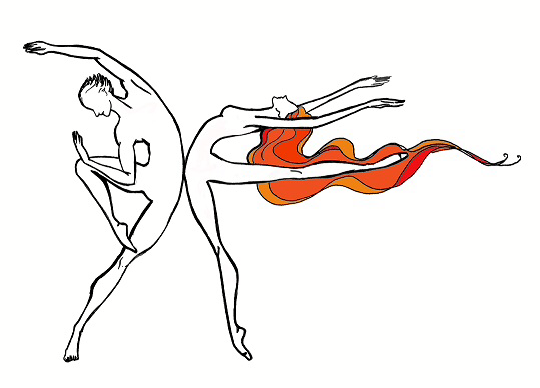
Dawn:
Our dance friends, Maggie and Ghislain, have been deeply involved in their autumn intensive this week. We attended their students’ showing on Friday and were again impressed by the seriousness, composure, and abilities of their students. Ghislain teaches Balanchine based classical ballet, Maggie does Graham based modern dance.
They address the audience is French and English as their students come from many countries. Maggie is Dutch, Ghislain French. They had sponsored a video showing of our work in 2015 because they wanted their students to see how artistic work can evolve over time, even when people get to our age! They are a lovely, hardworking couple, and we always like to connect with them when we are in Paris.

Dawn at La Favorite. We stopped in on our way home from the performance. It’s a nice friendly place on the Right Bank near St. Paul’s Cathedral that we often go to on the way back to the 11th or 20th.
The Alana Collection

The Art in their Home

The scultural quality attracted us to it
At the Chapel of the Lamb of God
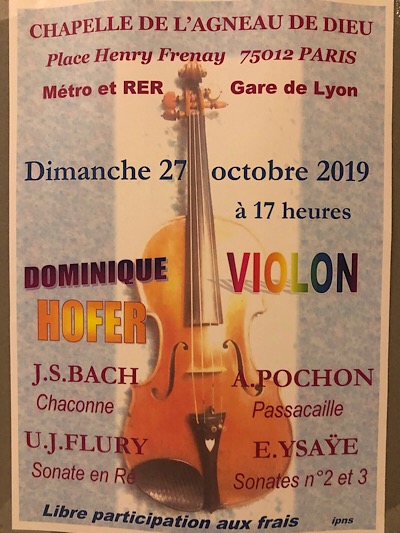
Dawn:
Dominique Hofer, he played fiercely, almost like he was angry. Starting with Bach’s wonderful Chaconne that brings back memories for me from age 17 at the American Dance Festival and José Limon. The other three composers he played were unknown to me, but fascinating: Pochon, Flury, and Ysaÿe. Only in the Malinconia of Sonate #2 by Ysaÿe did he play quietly...it was beautiful, such a welcome contrast in a room that was acoustically very bright. It was a technically demanding recital, and the musician took no breaks, including two encores. He was technically very much up to the task, but I questioned his musicality. He bowed stiffly and never smiled. Still, I complimented him on the concert. It was a tour de force. Like most of the recitals we have been hearing, it was free, but of course open to donations. We have been increasing the amount we give since we value hearing live music.
Stephen:
The concert started with some applause in the back of the chapel. The violinist came forward, took a stance and began to play. Until he announced his encore, not a word was spoken. Also, what has been strange is that none of the performers we have been hearing has any online presence. Maybe a youtube video or two, but no facebook page or website promoting their work or CDs. Odd.
Félix Fénéon at L’Orangerie Museum
He was a Parisian anarchist and art critic during the late 19th century. He coined the term "Neo-Impressionism" in 1886 to identify a group of artists led by Georges Seurat, and ardently promoted them.The Fénéon Prize was established in 1949 by his wife based on proceeds from the sale of his art collection. Sophie Maheu who we are about to visit in the next section has received one of these prizes.

We would bring these home in a heartbeat
Click here to see more of our l’Orangerie Photos and more about Fénéon
Dinners at the Grand Bain and Pane, Olivio & Pomodoro

Dawn outside the Grand Bain.

The blackboard was large and awkward to use in the crowded restaurant. It was easier to use the photo on m phone to pick the next course, and also to look at it to remember all the ingredients of what we were eating.
Stephen:
Our first forays into hipster Paris. We found le Grand Bain through lefooding.com. It was also a five minute walk from our apartment. It was a tapas place. We didn’t have reservations so they sat us at the bar, where we could watch the bartender make his drinks. The most memorable part was when he placed three ice cubes from the shaker into the drink. He used long tongs and selected them, sometimes rejecting one for reasons beyond me. And even though he was placing the cubes in the drink, he carefully placed his other hand as a shield against any splash reaching the customer. We ate: chanterelle mushroom, monkfish liver, cockles, beets, and rabbit. The place had a lot of energy and was somewhat chaotic. We could order from one of four people in front and there were three cooks in the open kitchen, one of whom liked to dance to whatever music came on. The orders all went into an ipad at the bar which kept order.
Two thing come up here. One is the fact that all we are listening to here is American popular music. In all the restaurants and bars. The second is as restaurants move to the outlying districts of paris because of high rents, they put more and more tables into the small spaces they use. I am waiting for the first restaurant where we sit in each other’s laps.
The second restaurant was the result of my search for comfort food Italian style using Google. Again, we had no reservations, but they found us a table. Again, we sat close to the other tables. The grilled vegetables, Porcini Ravioli in a Parmesan cream sauce and gambas with linguine were delicious and filling. At sometime during the evening, my fleece fell off the chair and was placed on another chair where it was covered with the coat of the young woman who was sitting next to us. As I was digging around for it she returned to the table from being outside, having a smoke. She claimed that my fleece belonged to her. I continued digging around, hoping to find a scarf or hat in the pockets to prove that it was mine when I looked up and realized I was being teased! She continued, suggesting that perhaps we should exchange coats, that hers might be très chic on me. If I had had room in the crowded restaurant, I might have tried hers on, but instead I said I would look much better on her. Dawn was chiming in, making communication possible, but also slowly devolving into Italian. It was fun!
Again, it was in the neighborhood, so an eight minute walk brought us home.
Visit to Sophie’s Studio
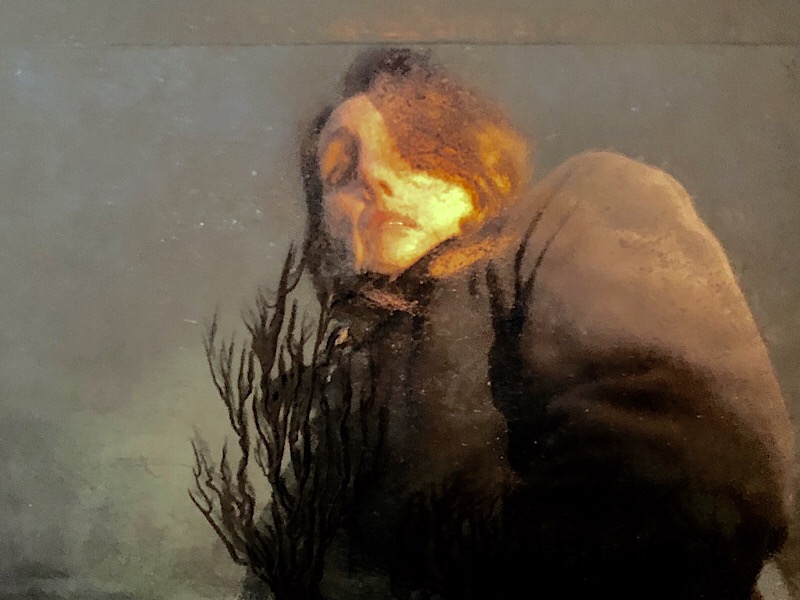
This is a photo of Dawn taken by using one of Sophie’s beautiful glass/tree pieces as a mirror.
Click here to see another photo.

After we bought the hat, Dawn was buying some silk scarves as gifts and I wandered off to get myself a new wool scarf so I would look more Parisian. Somehow we charmed the woman who sold me the scarf. She said we were a close couple, using crossed fingers from both hands, as opposed to a couple apart, pulling her hands apart. I had called for Dawn across the market to come look at this scarf before I bought it, because, well because that’s what we do. Dawn explained although it was my scarf, she would be the one that would have to look at it.
So this scarf seller has brought to a close the discussion about who knows whom and how well. What we are is close. For the good or the bad of it, for long periods of time we act as one. When we travel we are hardly ever out of each others’ sight. We act as one, we are one and it has made all the difference.
Naifs at the Maillot
Dawn:Sometime in the last year, I streamed a film from the library called Seraphine. It was a powerful, brilliantly acted story of a French former nun who became the housekeeper of Herr Uhde, an erudite German art critic, living in France between the wars. She heard voices from St. Mary telling her that she must paint. In the film, we see Seraphine, mixing paints from eggs, animal blood, and plants, and painting obsessively through the night. She paints flowers, but the flowers have an energetic presence on the surface. She uses whatever scraps of wood or other materials she can find on which to paint. One day Herr Uhde discovers her paintings and thinks they are special, unique, and worth selling...which he does. He buys her real oil paints and canvasses and sets her up with a studio and stipend to paint.The subsequent story is a tragic rise and fall of this obsessed woman, but the resulting paintings that we were privileged to see in this exhibition are indeed unique and magnificent. To my eye, they have a kind of Van Gogh-like energy. Seraphine is the only woman in this group of Naifs, and I think the best of them all!
Stephen:
The most interesting thing said about the Naifs was they went back to the Medieval style of painting. That might be true, but it is easy to see them as cartoonists. Serafine feels like she hasn’t gone anywhere except her own heart and mind. Her life ended badly, dying in an institution.
Marieline’s place
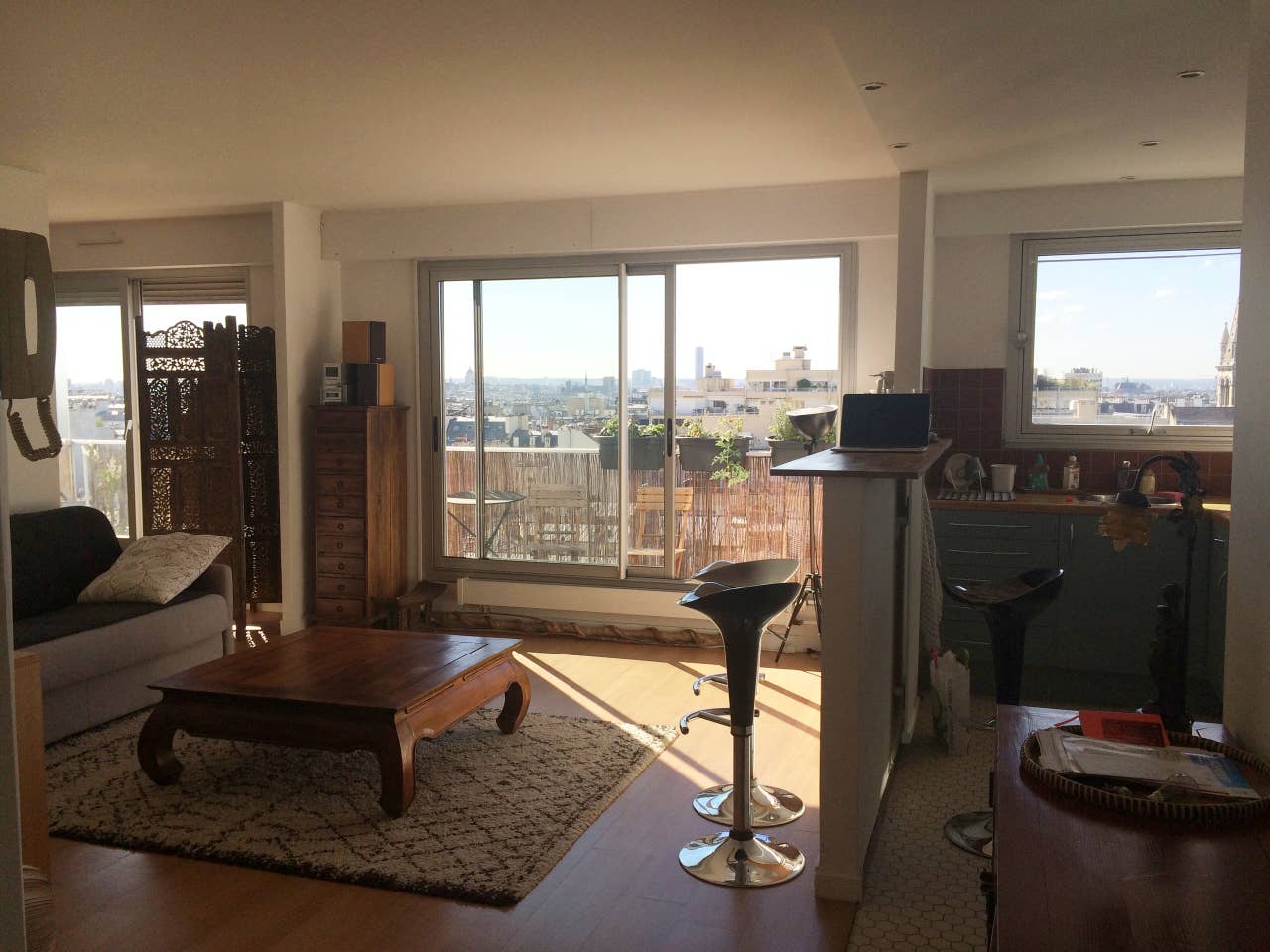
This is our view when we walk in the front door from the Airbnb website.

Night view from the apartment that we took.
The bed is comfortable. Everything works. The kitchen is easy to use. The place is very comfortable to hang out in after a hard day at the museums. The view is in your face all the time through the glass sliding doors.

I thought it looked like Minimalist art, but it is just a photograph of a mirror on the wall in the apartment.
Odds and Ends

After a nice visit with some friends from California, Jonathan and Karin, at their hotel, we walked through a beautiful part of Paris in the Sixth on the way to have dinner with Isabelle and Jean at Moufftard Saigon’s near Place Contrascarpe. It was great to catch up with their lives.
(top)
Wrap up
Dawn:A few odd, last-minute memories: One day the elevator opened on the ninth floor, containing boxes and milk crates of stuff and a young man. He said we should get on as he moved one box on top of another to make room for us. It seems he was moving some of his belongings down to the basement storage room. Maybe he was prepping his apartment for Airbnb? A prominent crate was filled with liquor bottles. In French, he said “Well, I would invite you for a martini, but...” We all chuckled, then wished him a bonne journée.
It was raining on our last day so we decided to spring for a G7 cab to the airport, the only one we took during our time in Paris. G7 is an app like Lyft. It was Toussaint, All Saints Day, a big Catholic holiday in France, so I figured we would likely have a Muslim driver. Chatting with the driver about the frequent grèves (strikes) in Paris, I recounted the story of my long, circuitous underground trip from the Basilica St. Denis, way north of Paris, to return to the fifth arrondissement where I was staying with friends years ago. It was after a concert, late at night. Some of the Metro lines were on strike so it seems that I had to travel under the entire city to get back, plus I couldn’t understand the announcements because French is not my first language.
He said I got along well in French and asked where we were from. When he arrived in Paris 45 years ago, he didn’t know a word of French and had to work hard to learn the language. It turns out that he emigrated from Israel after the 1967 war. He also mentioned that he was soon going to visit family in Brooklyn. Although I didn’t ask, I wondered why he chose France over Brooklyn which seems like such a welcoming home for so many Jews, plus he apparently has family there.
We are home now. It is cold and crisp, but the sun is out. We spent a few hours raking leaves today, and now I sit looking out our big kitchen windows at gently blowing trees with golden leaves.
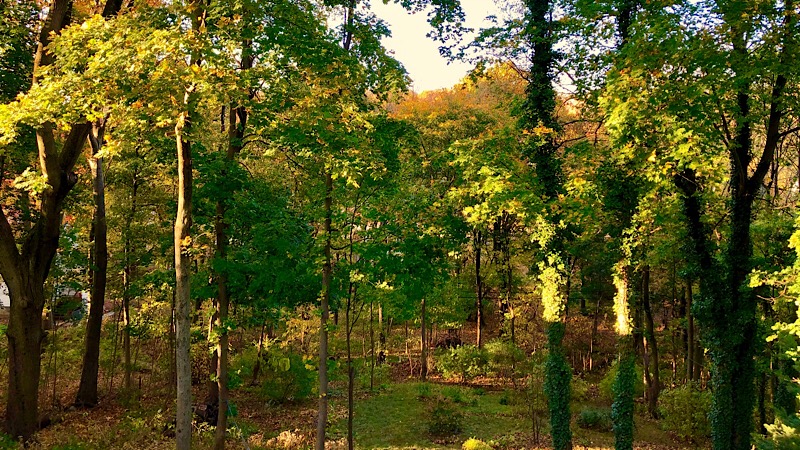
View of the woods behind our house
Stephen’s Final Word:
Soon after we arrived at the airport, gone through all the lines, seemingly been poked and prodded by all the authorities, we got to our waiting area only to find that our flight was to be delayed by three hours and twenty minutes. Since we were there two hours early...you do the math. We had various encounters with the food purveyors before we could find something good to eat.
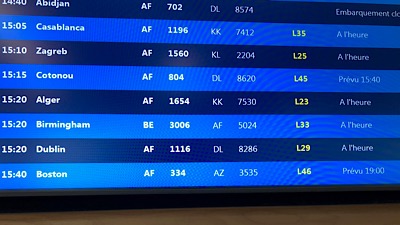
The lowest line on the board is our bad news.
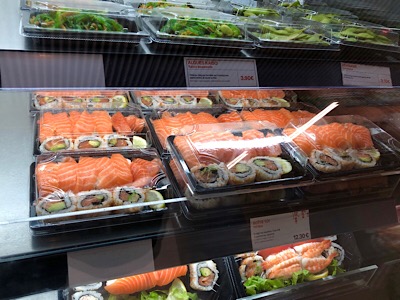
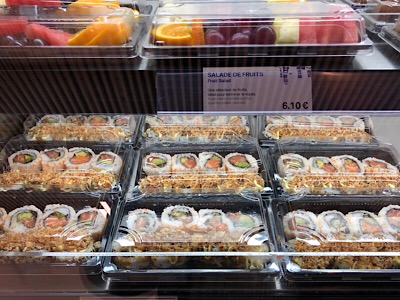
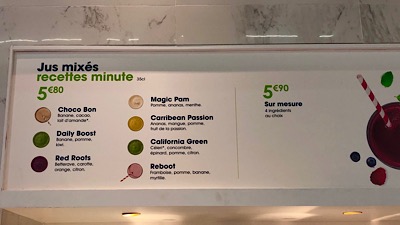
Too much food in plastic/The sign with the vanished smoothies
When they changed our gate, we stayed at the old one reasoning that the new waiting area would be filled with grumpy passengers. We wrote our review of Marie-line’s apartment. Dawn found a cute tin of mints for Tess.
After many hours they announced that we all had to come up and get our passports checked again or the Americans wouldn’t let us in. We refused to stand in another line, deciding to be the last on board and just stayed in our seats. We were in group five, so we woud be the last to board. I bought seats in the back of the plane where the plane narrows and we woud have a window and an aisle seat. They would be there when we got there, but we had no chance of getting overhead bins for our bags. Surprise, surprise, a small empty bin waited for us over our seats into which our bags fit snugly. The food is good.
BUT, none of this is my final word. As we got on the plane, the attendants were waiting for us to show our tickets so they could send us down the correct aisle. My ticket was already put away so after Dawn showed hers, I just said, "I’m with her." One of those handsome stewards looked at me and said, "Lucky you." So my final word, actually three, is "Yes, lucky me."
The Travelogue is done, but below is a bonus of photos from some Paris Museums. We felt, considering all the museums in Paris, these photos should have their own place to avoid cluttering the narrative.
Thanks for reading,
Dawn and Stephen
(top)
Additional Paris Museum Photos
Musee Guimet


Contemporary Japanese Art
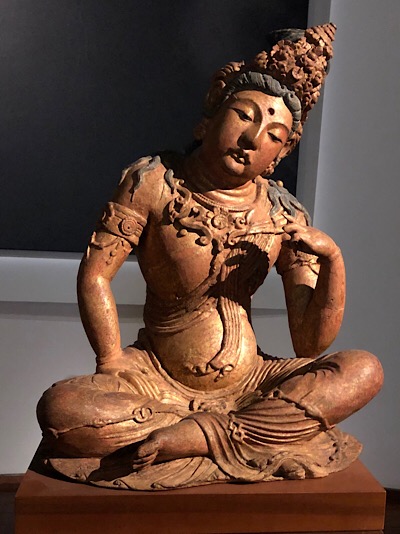

I assumed they are feminine, but it is hard to tell. We have a second admission with our tickets. Dawn wants to return and get all the labels correct.


The Arhat (R) doesn’t look at ease in his enlightened state.


A Beautiful Wall of Art with a detail below it.
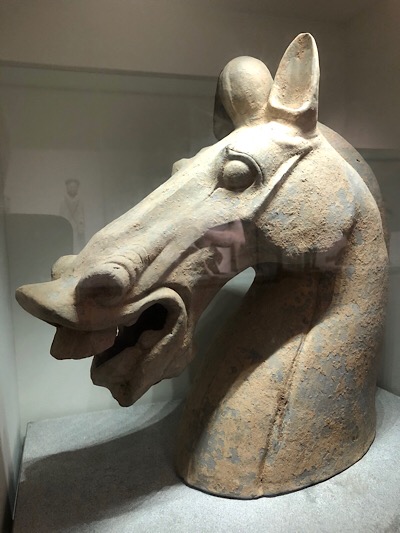
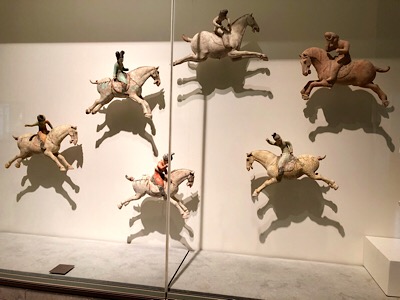
The horsehead was just odd in all of this old Asian art. Same for the polo players.


Two Beautiful Monks


Taken for the potters in our group. We have realized that in its time almost all the ceramics that we saw today were breakthroughs in their own time, in glazing techigue or firing technique. As they say, 'All Art is Modern'.


The sitting man is stunning in his sitting / Dancer


Contemporary piece by Takahiro Kondo

Back to Paris Travelogue at Guimet
El Greco
At the Grand Palais, a sweeping collection, but nothing from the Prado in Spain.

St. Francis

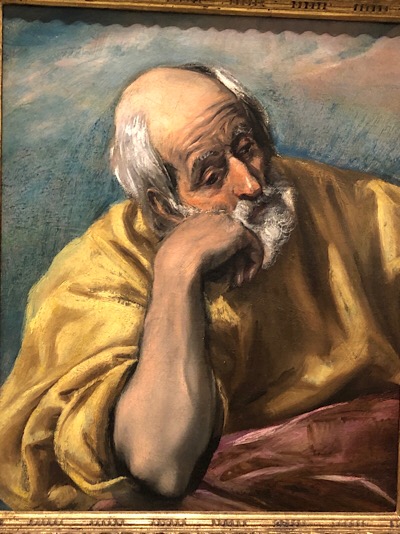
St. Peter and Joseph

An intellectual friend of El Greco.


A really strange treatment of the Lord risen. You do not often see portrayals of the naked Jesus and you do not see him standing on an iron rod. The statue is about a foot tall.


A detail of the market in front of the temple and our crowd today.

Descent from the Cross/Pieta


Details from the above


Crucifixion, I wanted more weight./Looks like the model for a lot of paintings a couple of centuries later.
Back to Paris Travelogue after Greco
The Alana Collection
From a Private Collection at the Jacquemart-André Museum
The paintings in their home


Jesus carrying the cross / Crucifixion


Two Annunciations

My favorite (JSB)


Saint John, the Evangelist/Christ

Saints Peter and Paul

We never did figure out this painting.

St. George and the Dragon
Back to Paris Travelogue after the Alana Collection
Fénéon at the Orangerie
Félix Fénéon was a Parisian anarchist and art critic during the late 19th century. He coined the term "Neo-Impressionism" in 1886 to identify a group of artists led by Georges Seurat, and ardently promoted them.The Fénéon Prize was established in 1949 by his wife based on proceeds from the sale of his art collection.
He was a prominent literary stylist, art critic, and anarchist born in Turin, Italy in 1861. He moved to Paris to work for the War Office where he achieved the rank of chief clerk. During his time in the war office he edited many works, including those of Rimbaud and Lautréamont, as well as helped to advance the fledgling pointillist movement under Georges Seurat. He was also a regular at Mallarmé's salons on Tuesday evenings as well as active in anarchist circles.
Fénéon, ironically, worked 13 years at the War Office while remaining heavily active in supporting anarchist circles and movements. In 1894 Fénéon was arrested on suspicion of conspiracy because of an anarchist bombing of the Foyot restaurant, a popular haunt of politicians.[1] He was also suspected of connection with the assassination of the French President, Sadi Carnot, by an Italian anarchist. He and twenty-nine others were arrested under charges of conspiracy in what became known as the Trial of the Thirty. Fénéon was acquitted with many of the original thirty. However, the trial was a high point in publicity for Fénéon, normally behind the scenes.
After the trial, Fénéon became even more elusive. In 1890, the Neo-Impressionist Paul Signac asked to produce a portrait of the lauded critic. Fénéon refused several times before agreeing, on the condition that Signac produced a full face effigy. Signac naturally refused, painting instead a famous profile of Fénéon with his characteristic goatee, a picture that largely became a symbol of the movement, spawning many variations. Fénéon, though displeased, hung the picture on his wall until Signac's death 45 years later.
His lawyer offered him a post at La Revue Blanche after the trial and his subsequent expulsion from the War Office; he worked for that magazine until 1903. In that time, he went on to promote the works of Seurat and Signac through the magazine. He organized the first retrospective of Seurat's work in 1900. Seurat is known for a number of works, most significantly La Grande Jatte. Hajo Dü chting, the author of Seurat, The Master of Pointillism notes that "Actually he (Fénéon) was the only critic who proved capable of articulating an appreciation of Seurat's picture, and the new method of painting it exemplified, in words notable for their objective tone".

We would bring these home in a heartbeat

His clothes on the hooks expose his real life, By Luce

Seurat

Closeup of Seurat

Henri-Edmond Cross
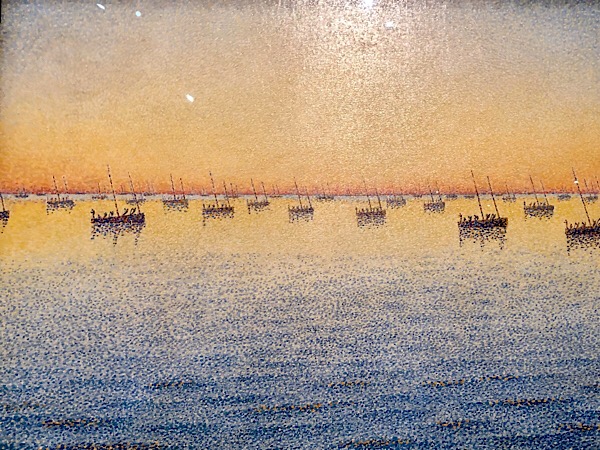
Seurat
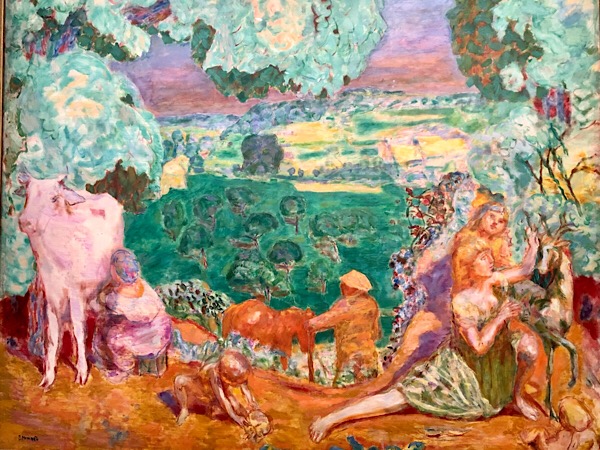
Matisse

Italian Futurist, Giacomo Bala

Another Italian Futurist,
Back to Paris Travelogue after the Orangerie
Visit to Sophie's Studio
Another photo that is the result of some fooling around with camera. Maybe something will come out of it.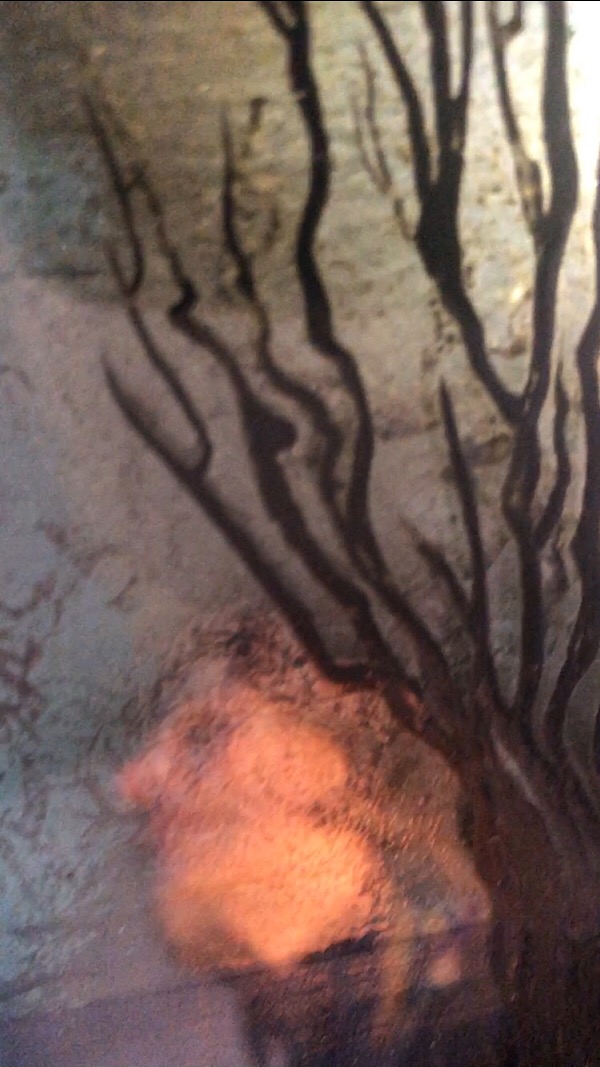
,
This are photos of Dawn taken by using one of Sophie's beautiful glass/tree pieces as a mirror.
Back to Paris Travelogue after our visit to Sophie's Studio

